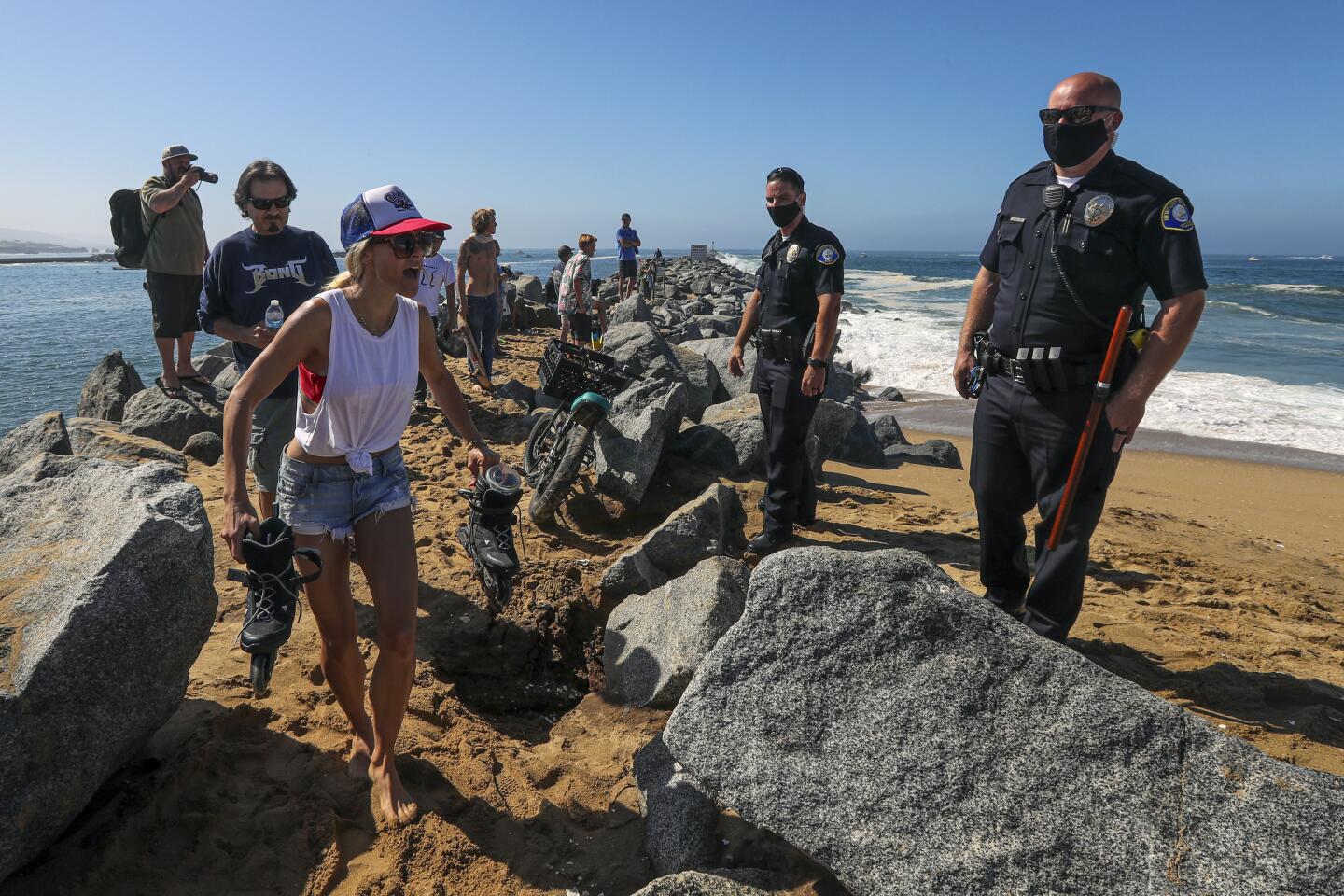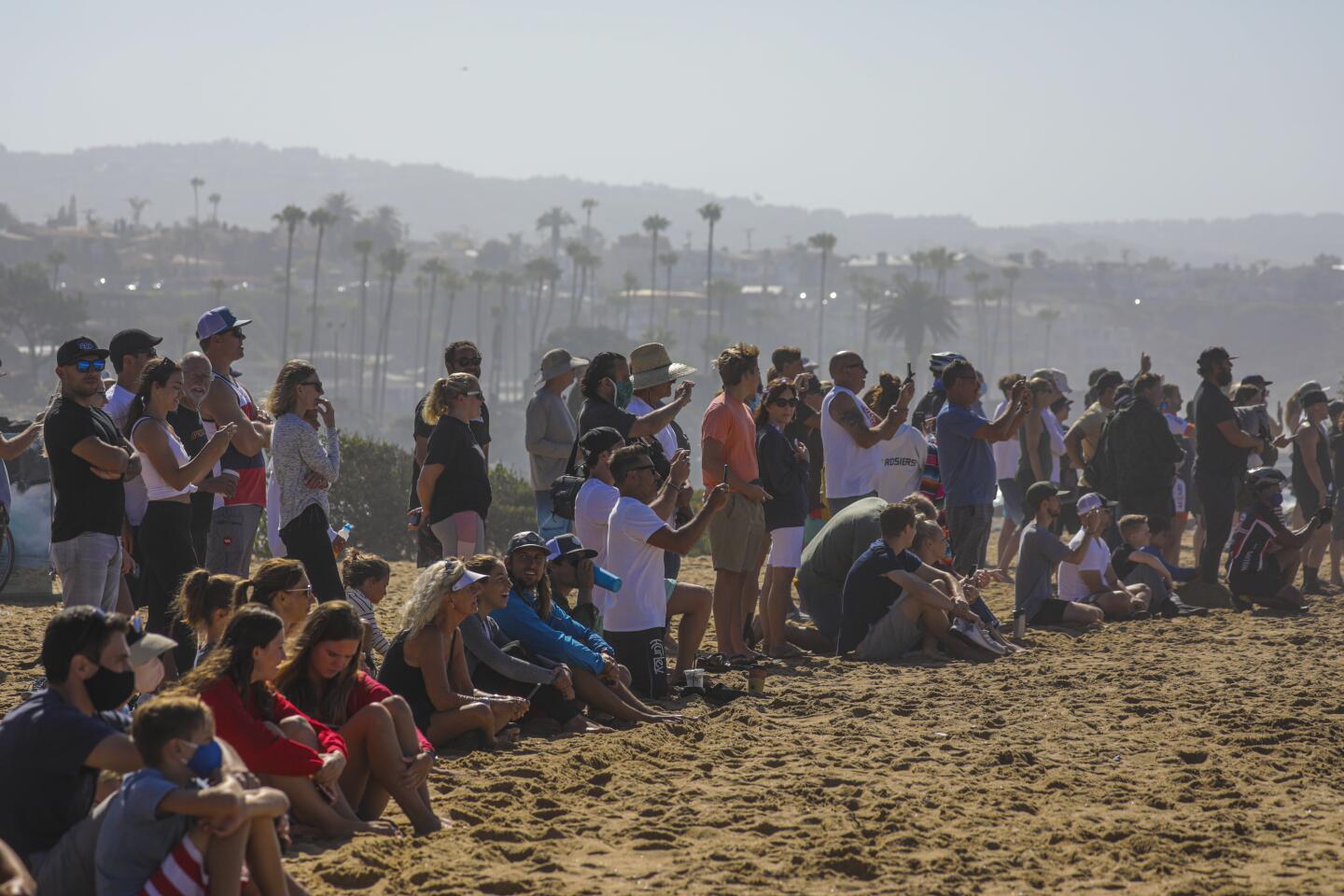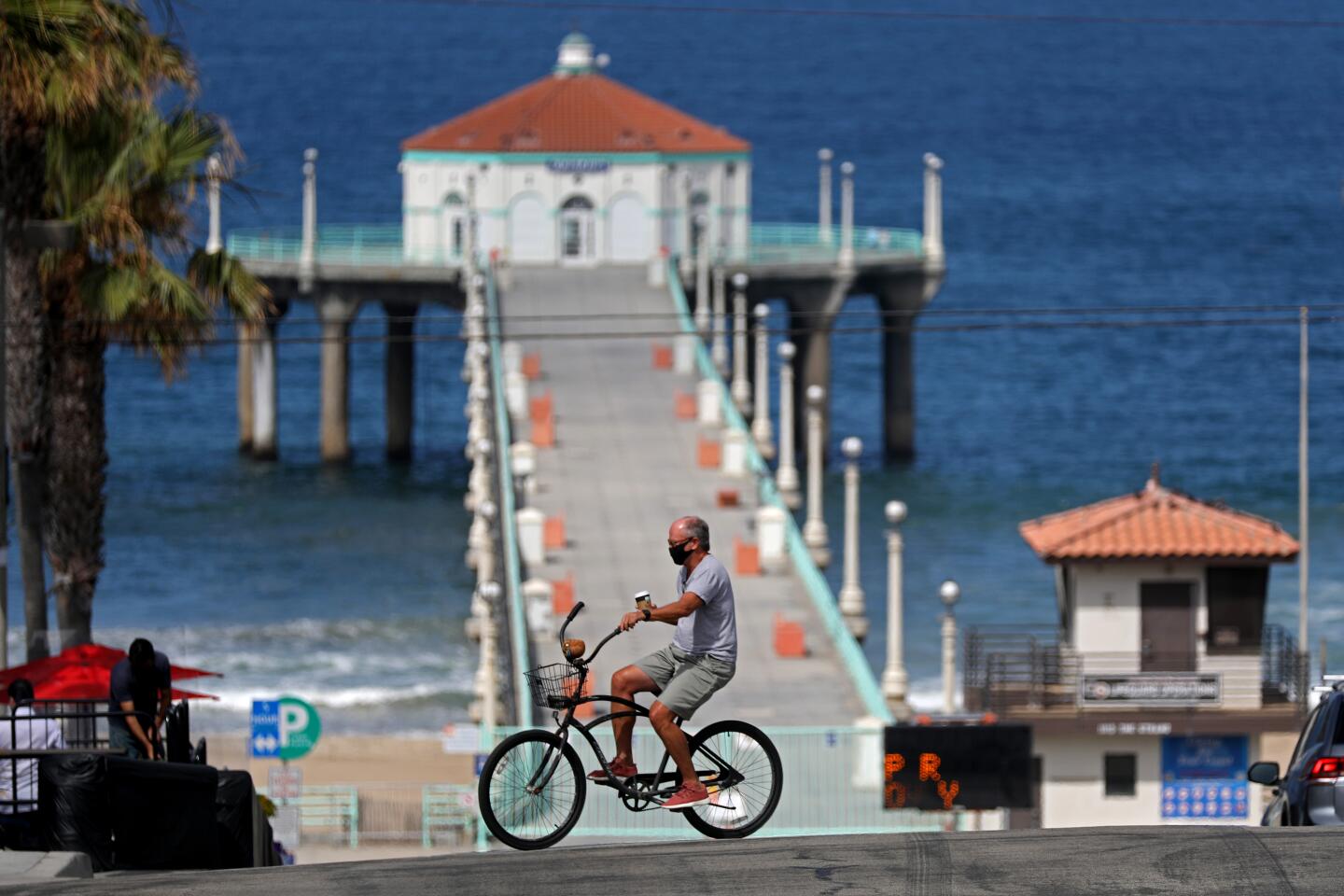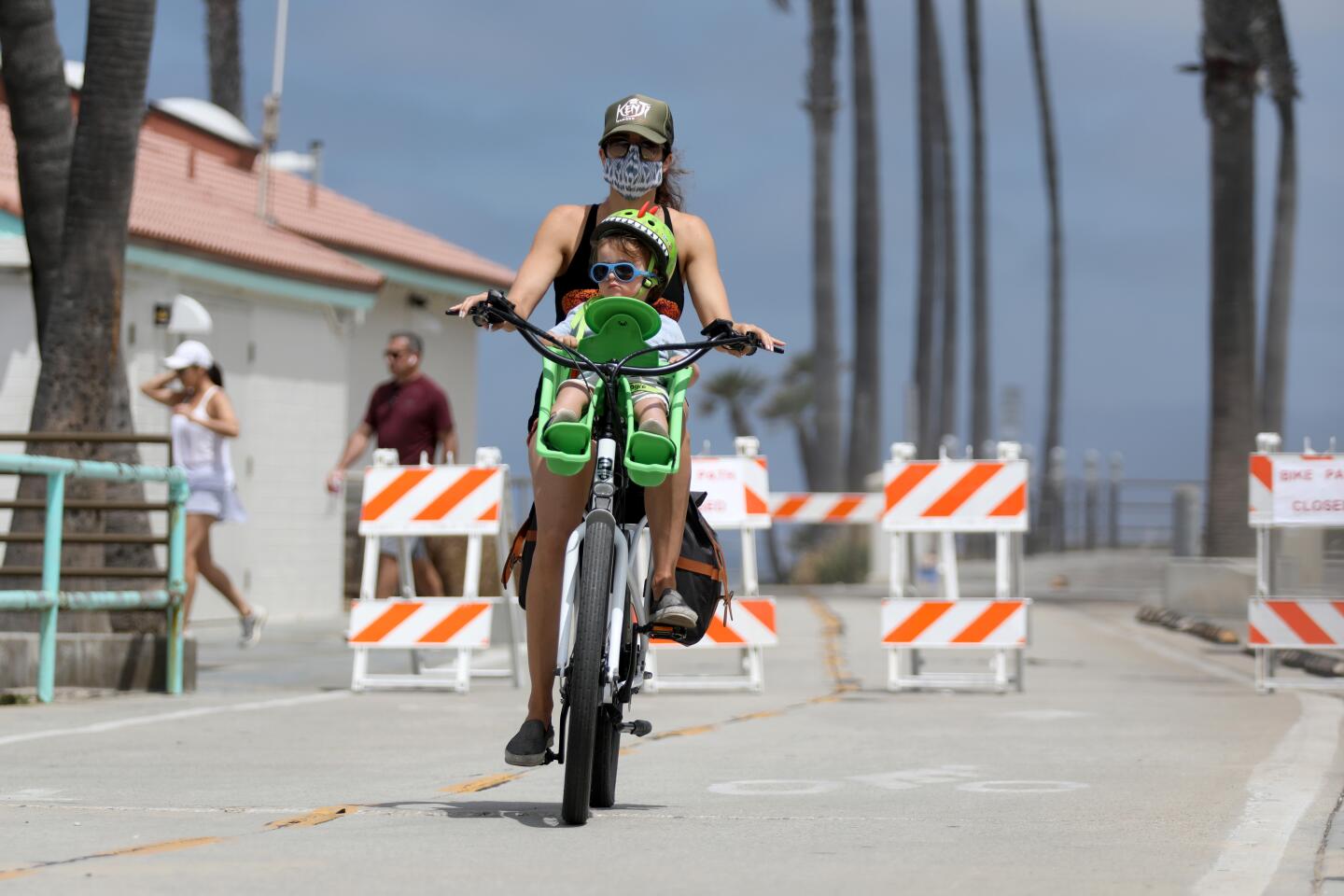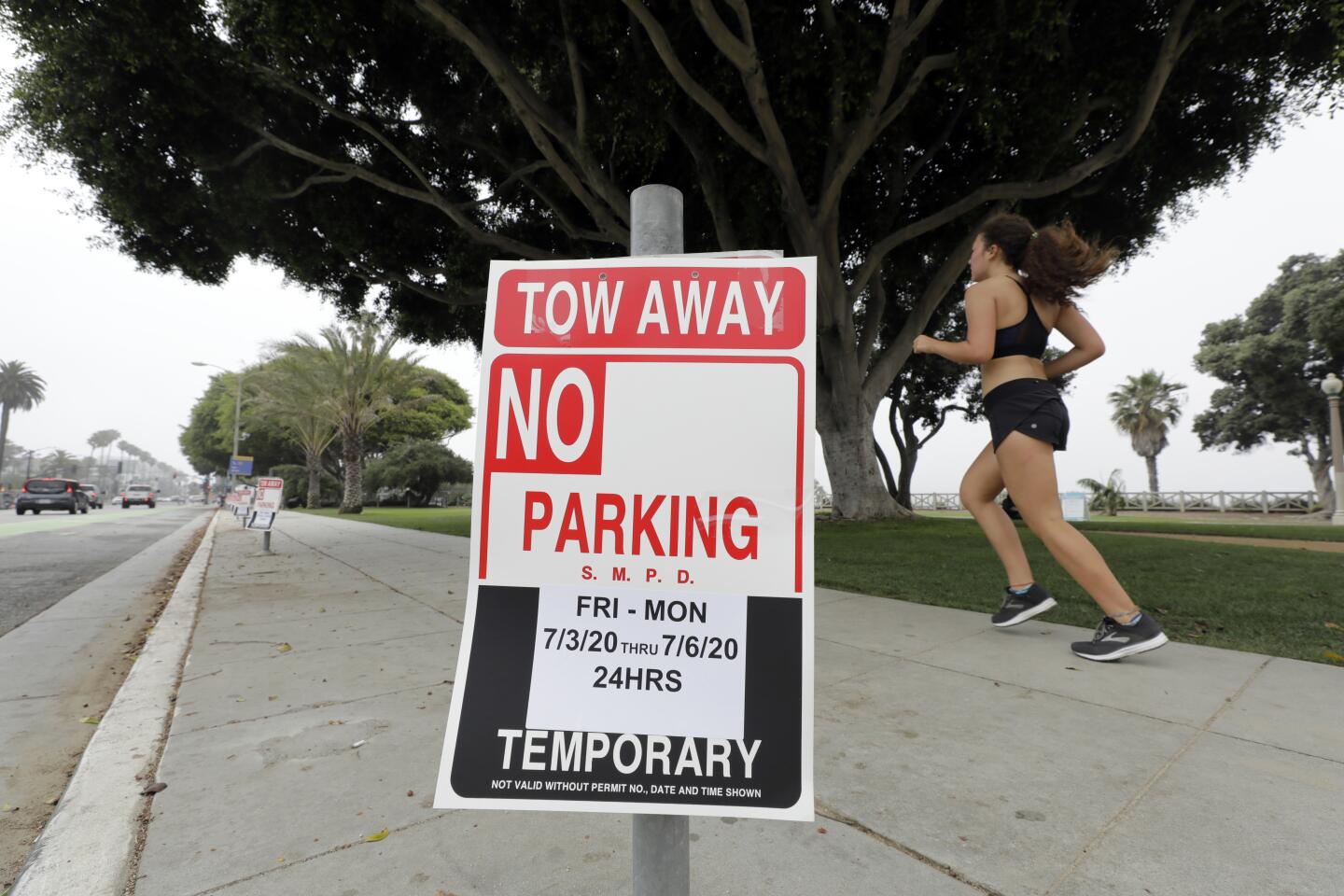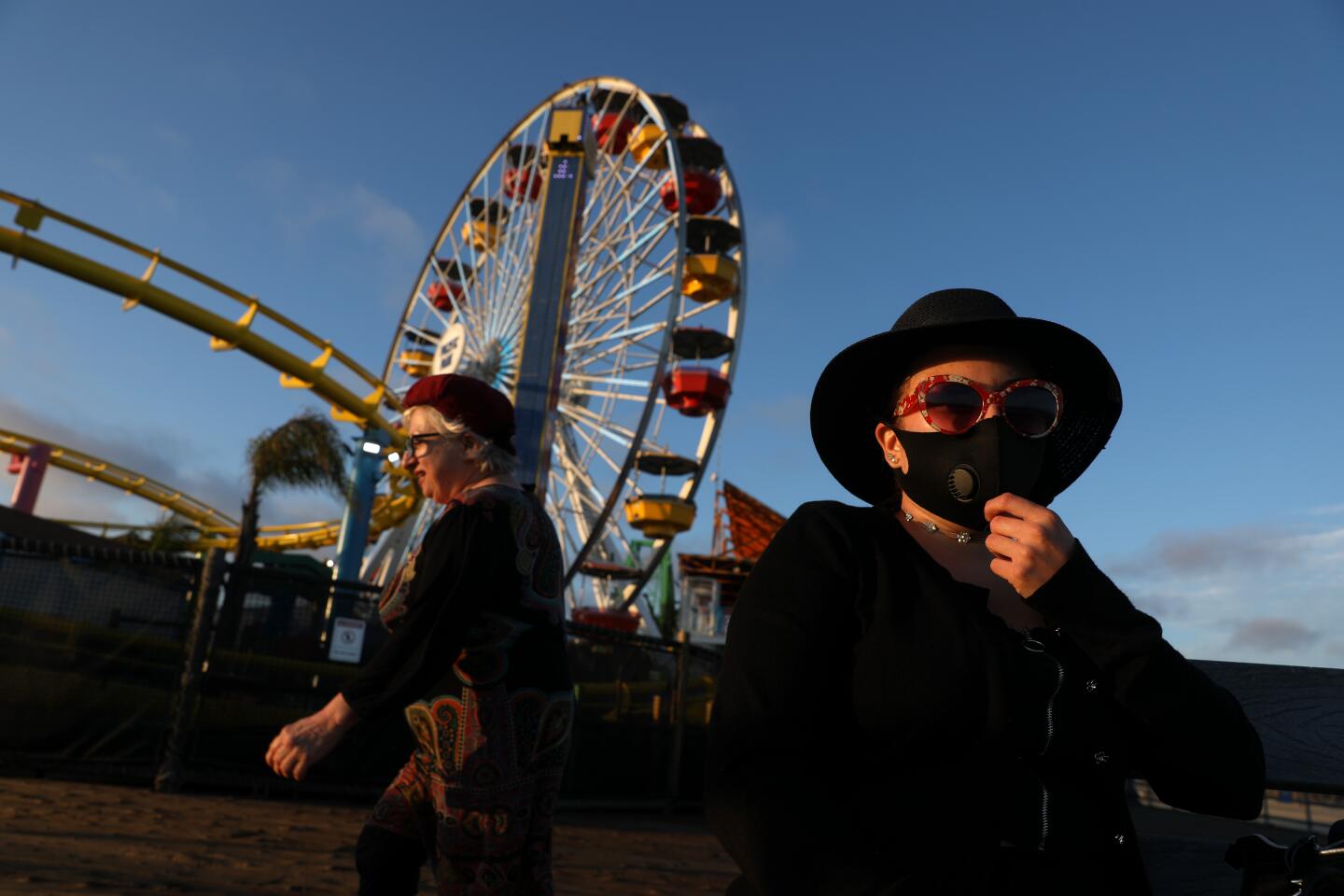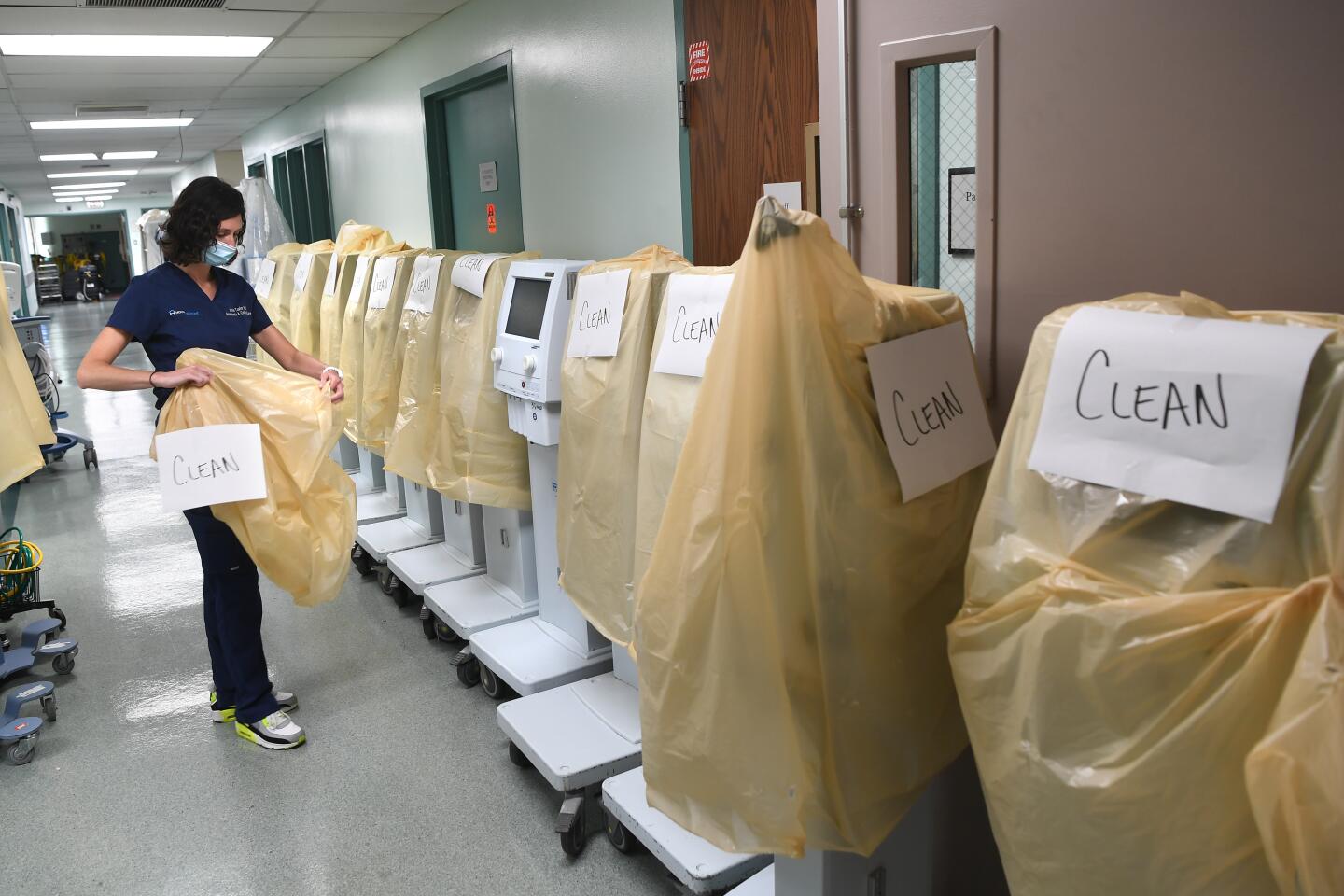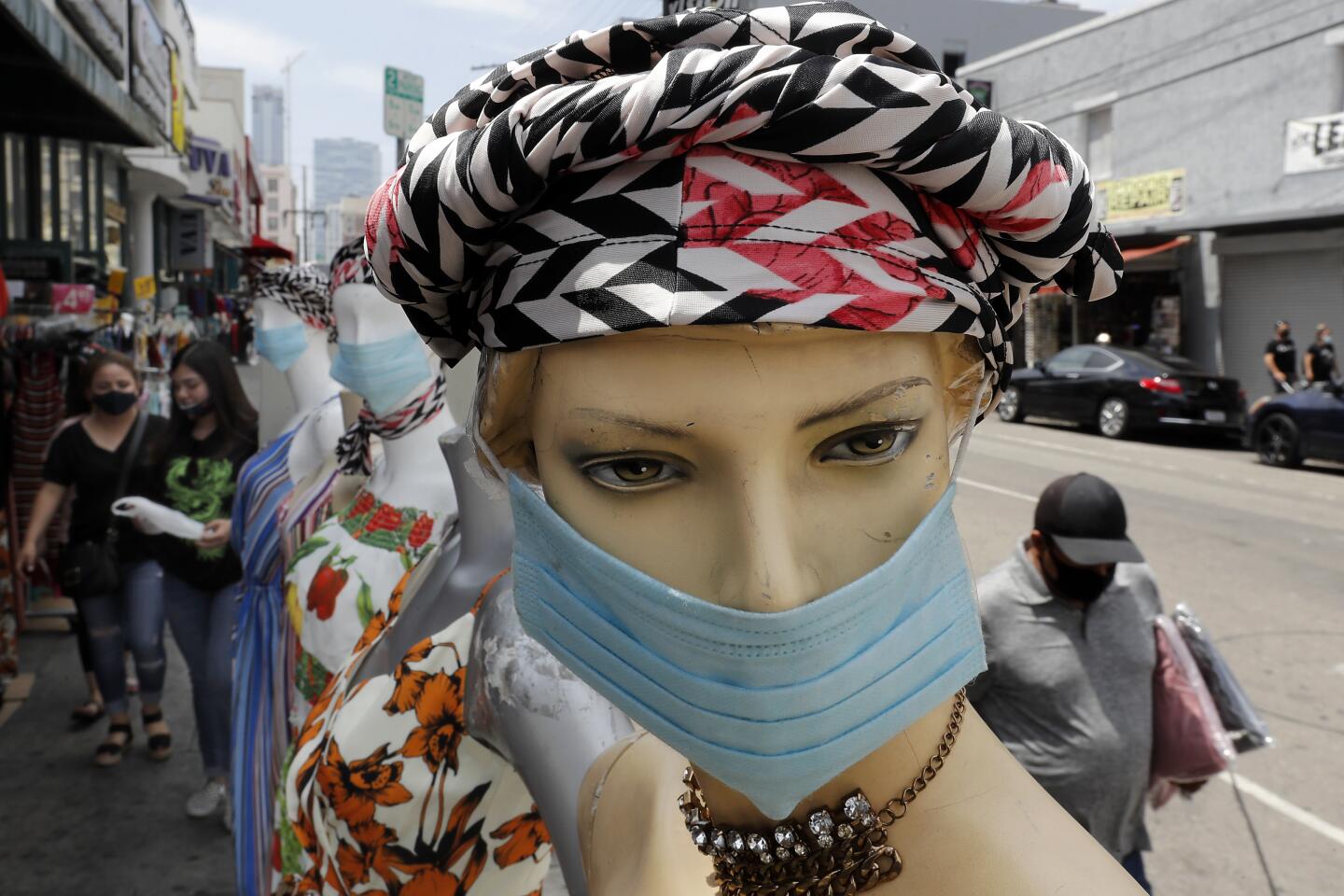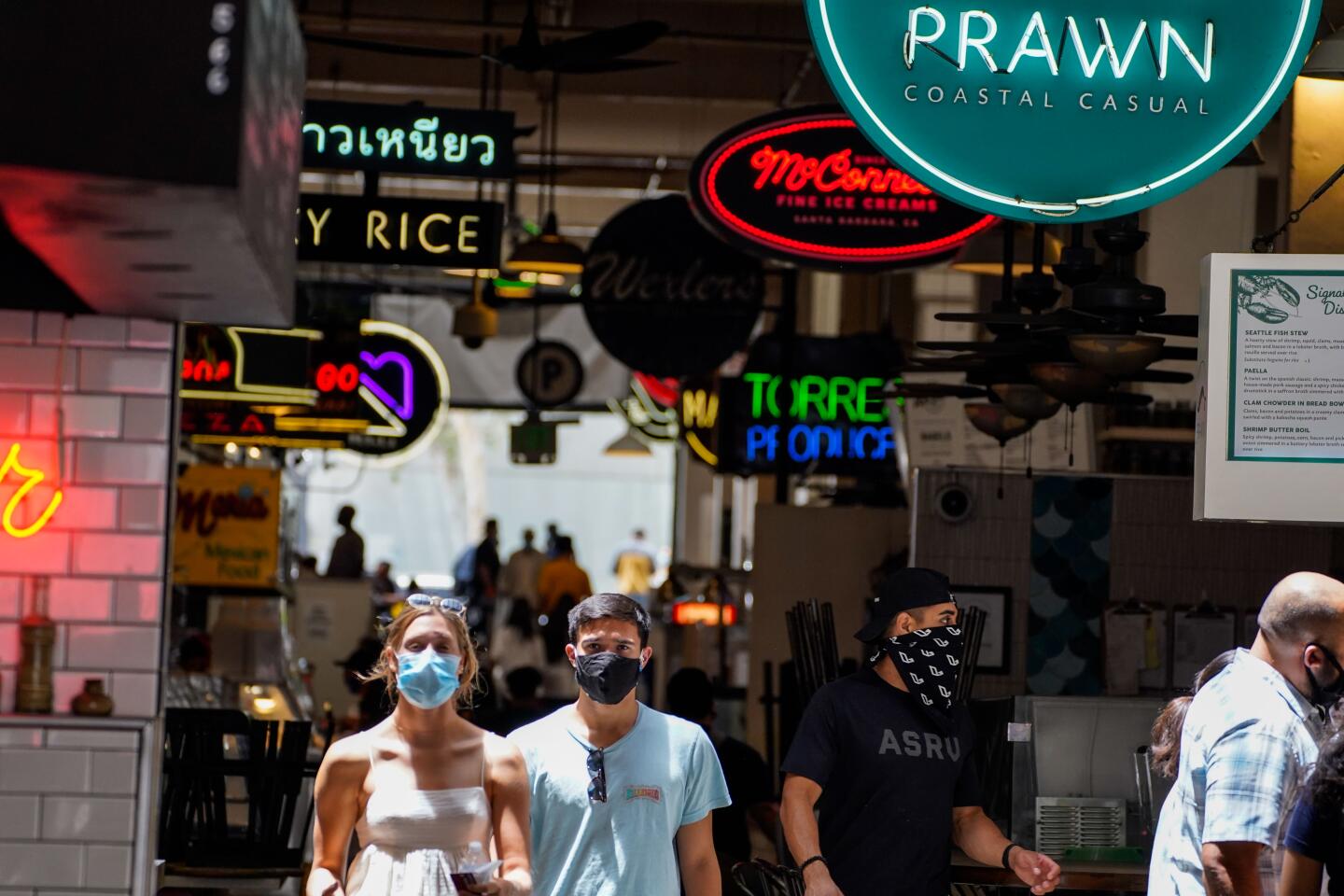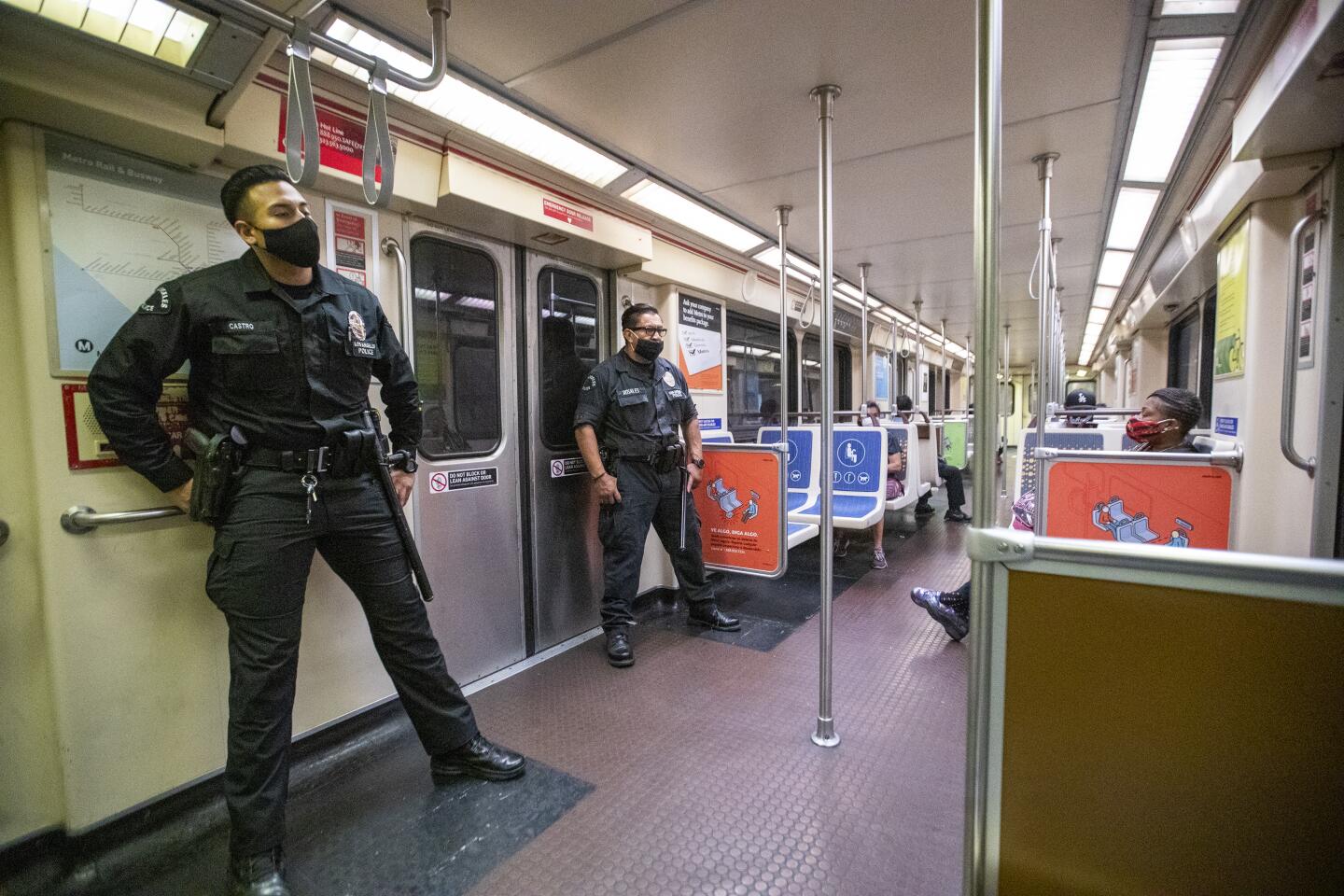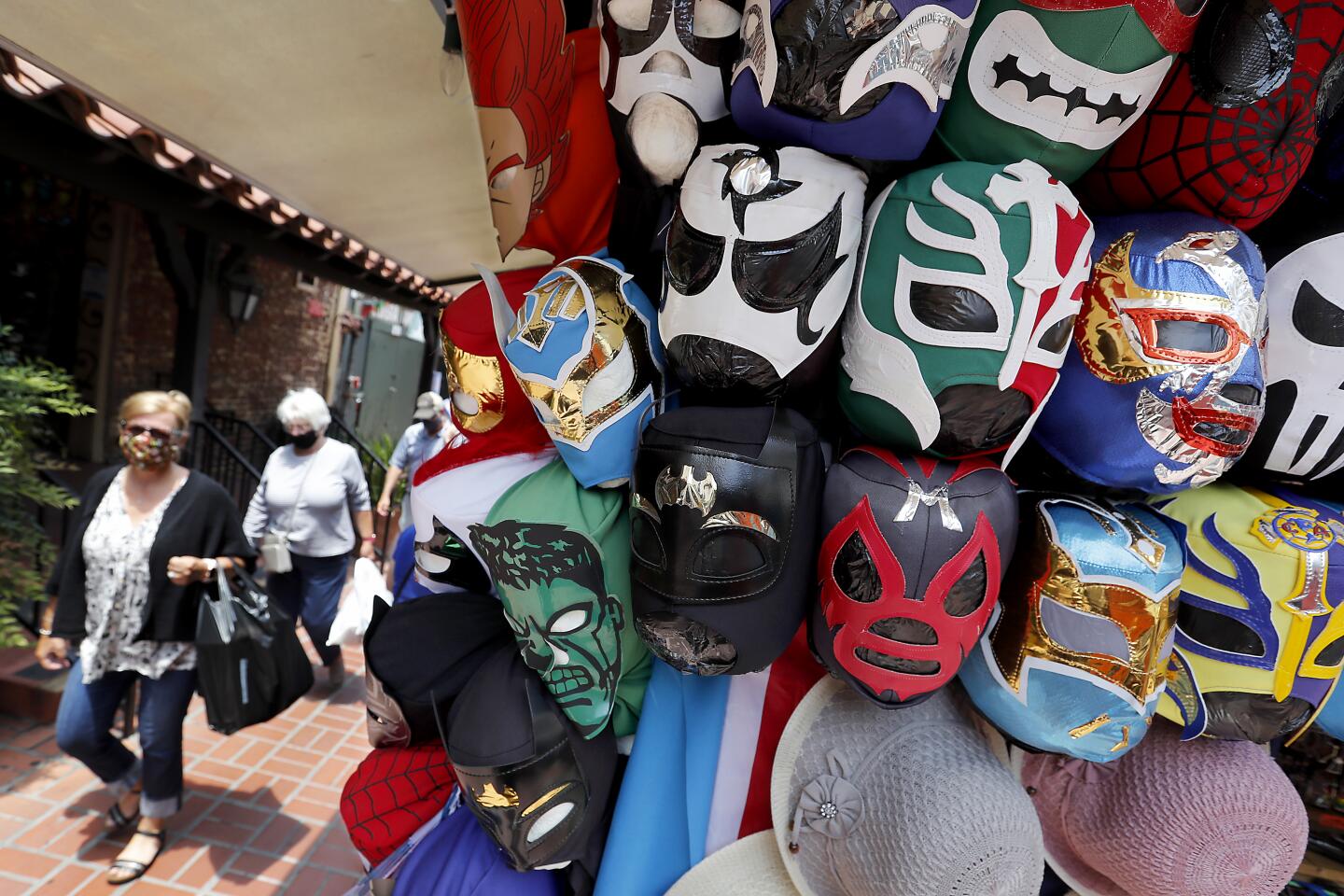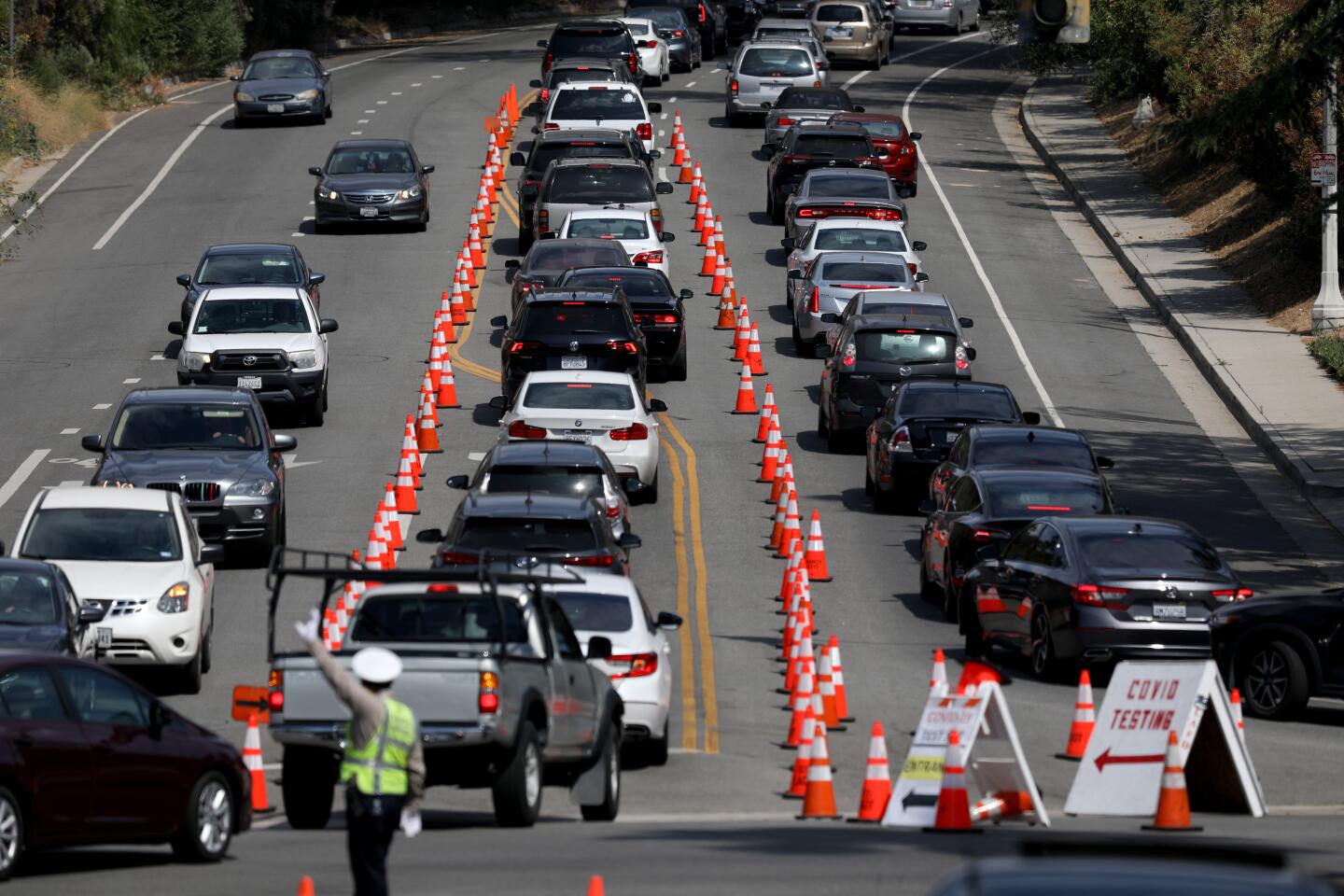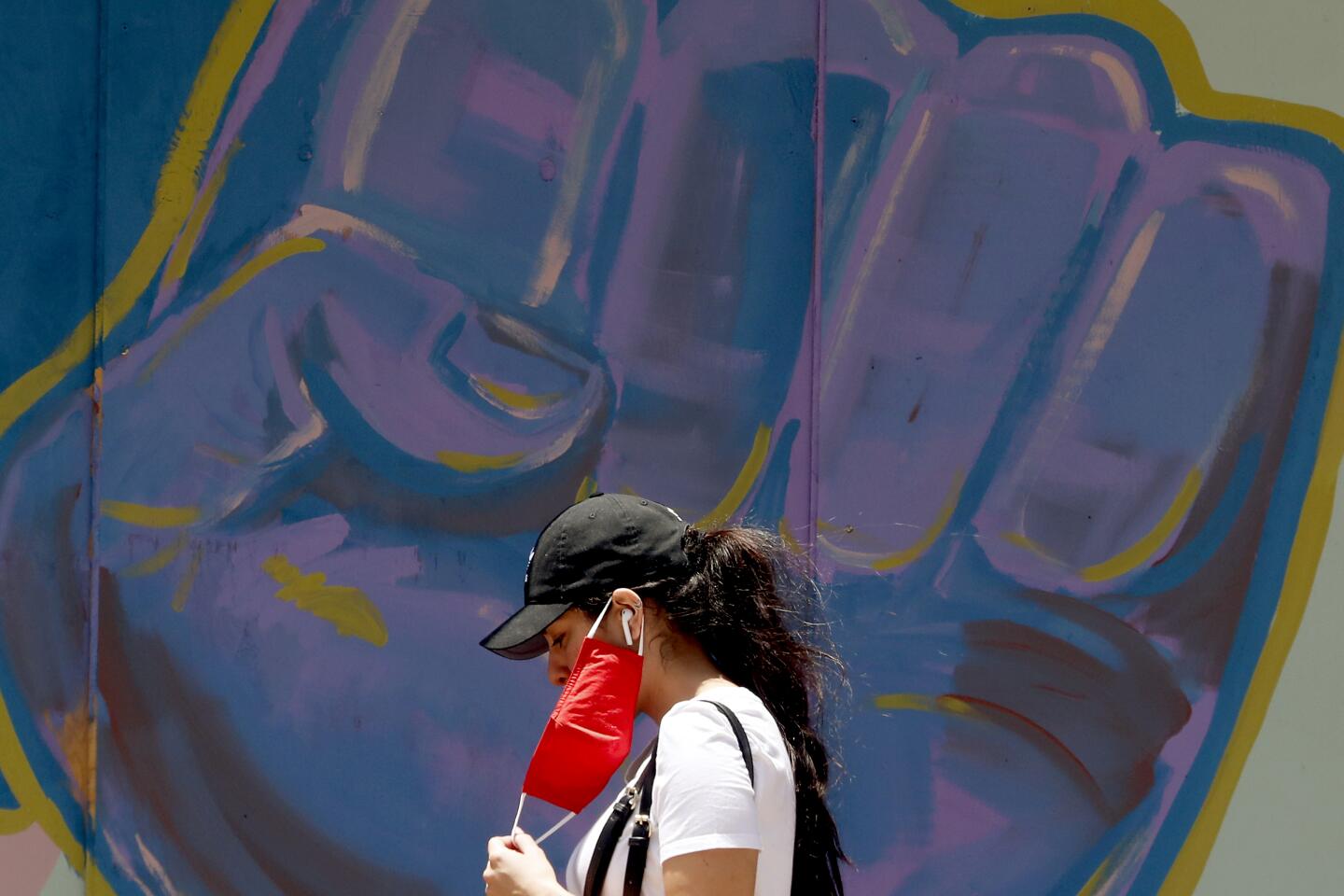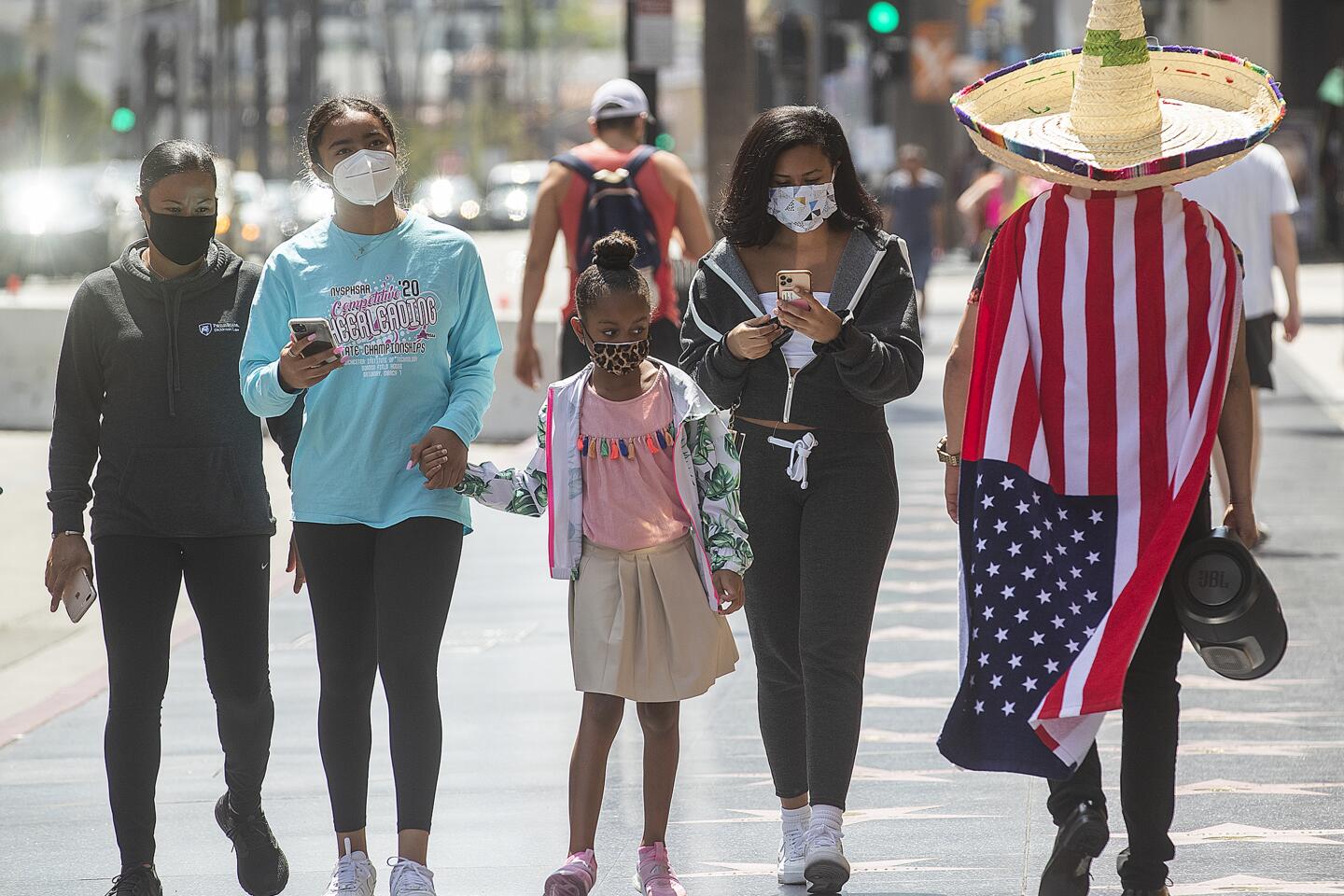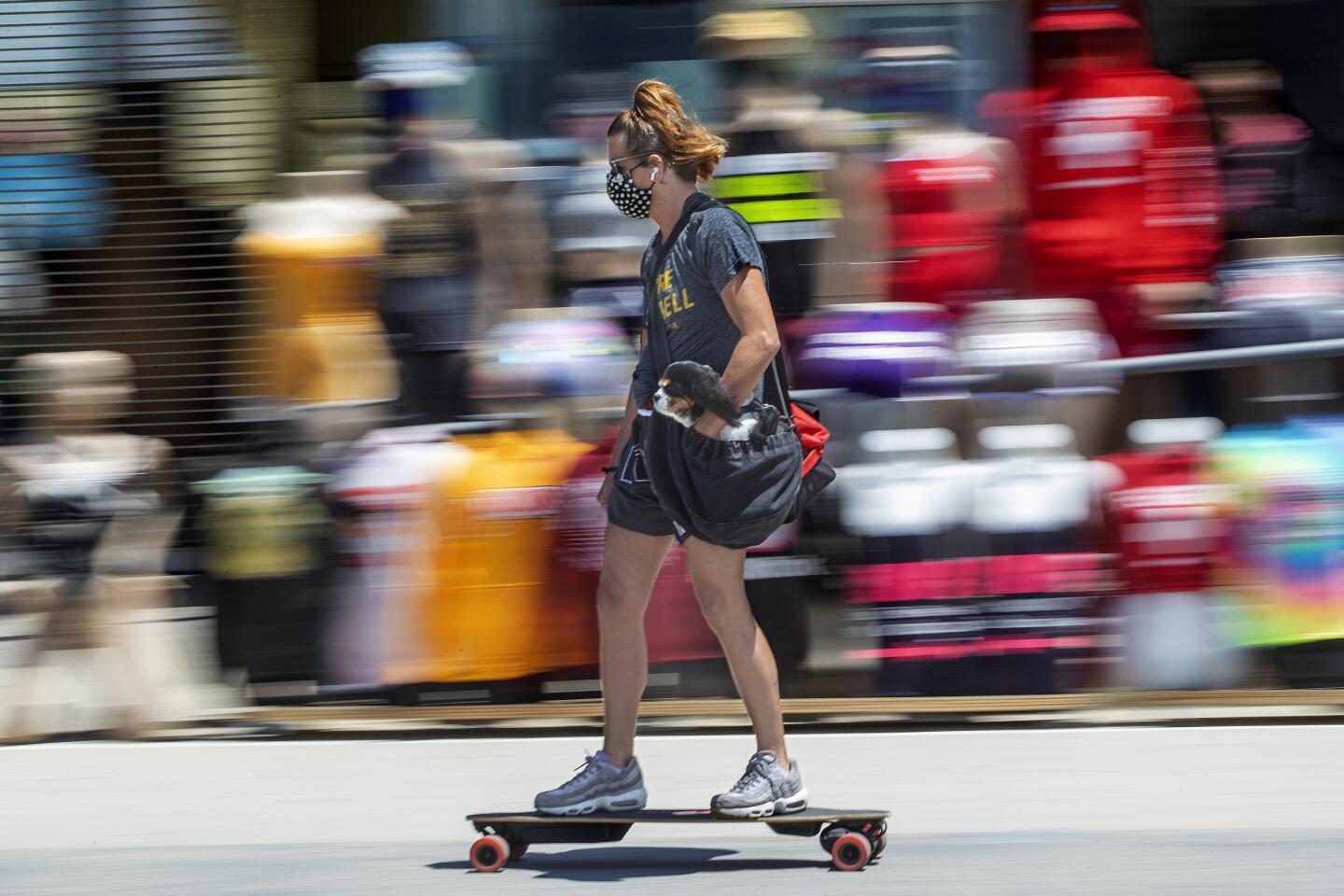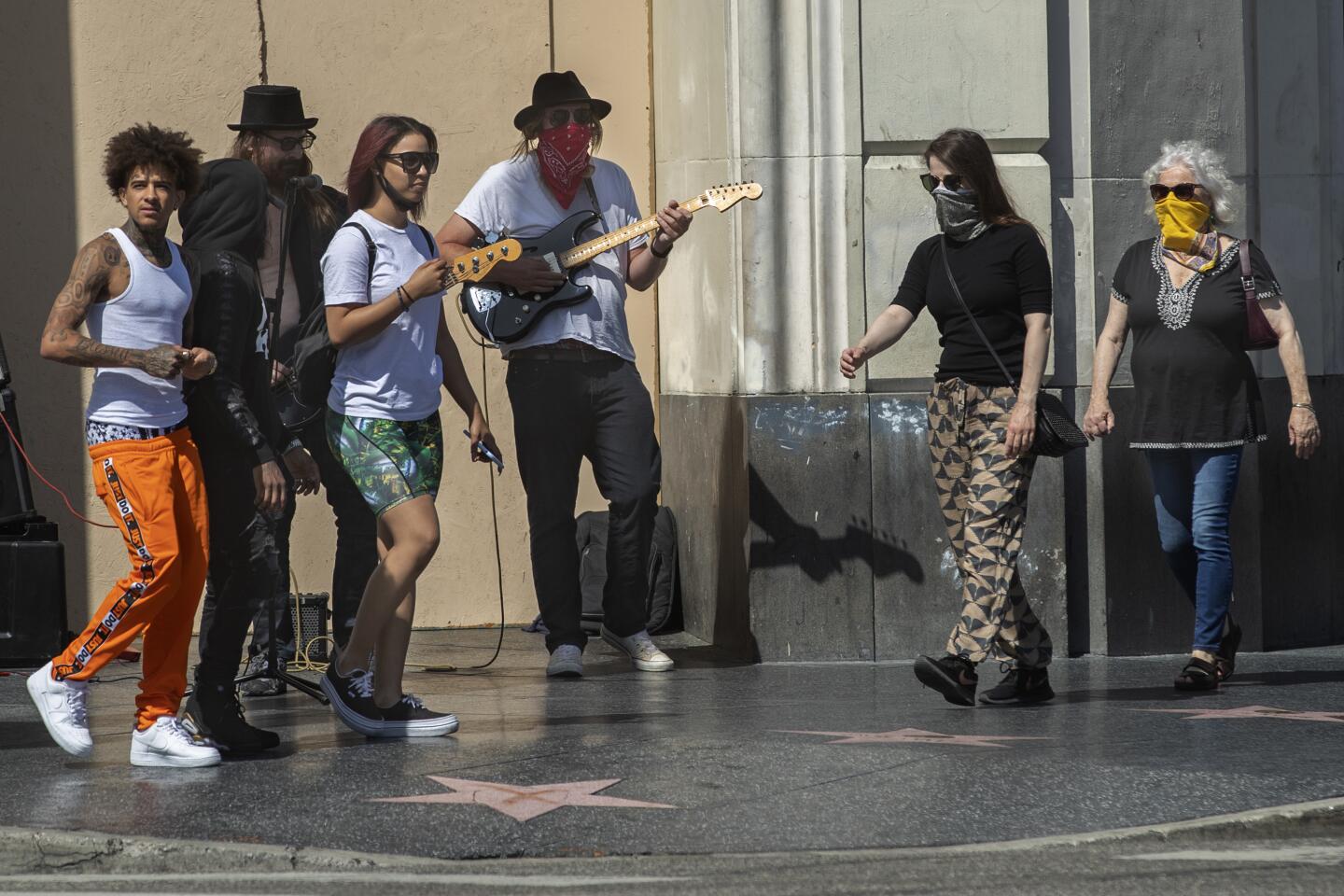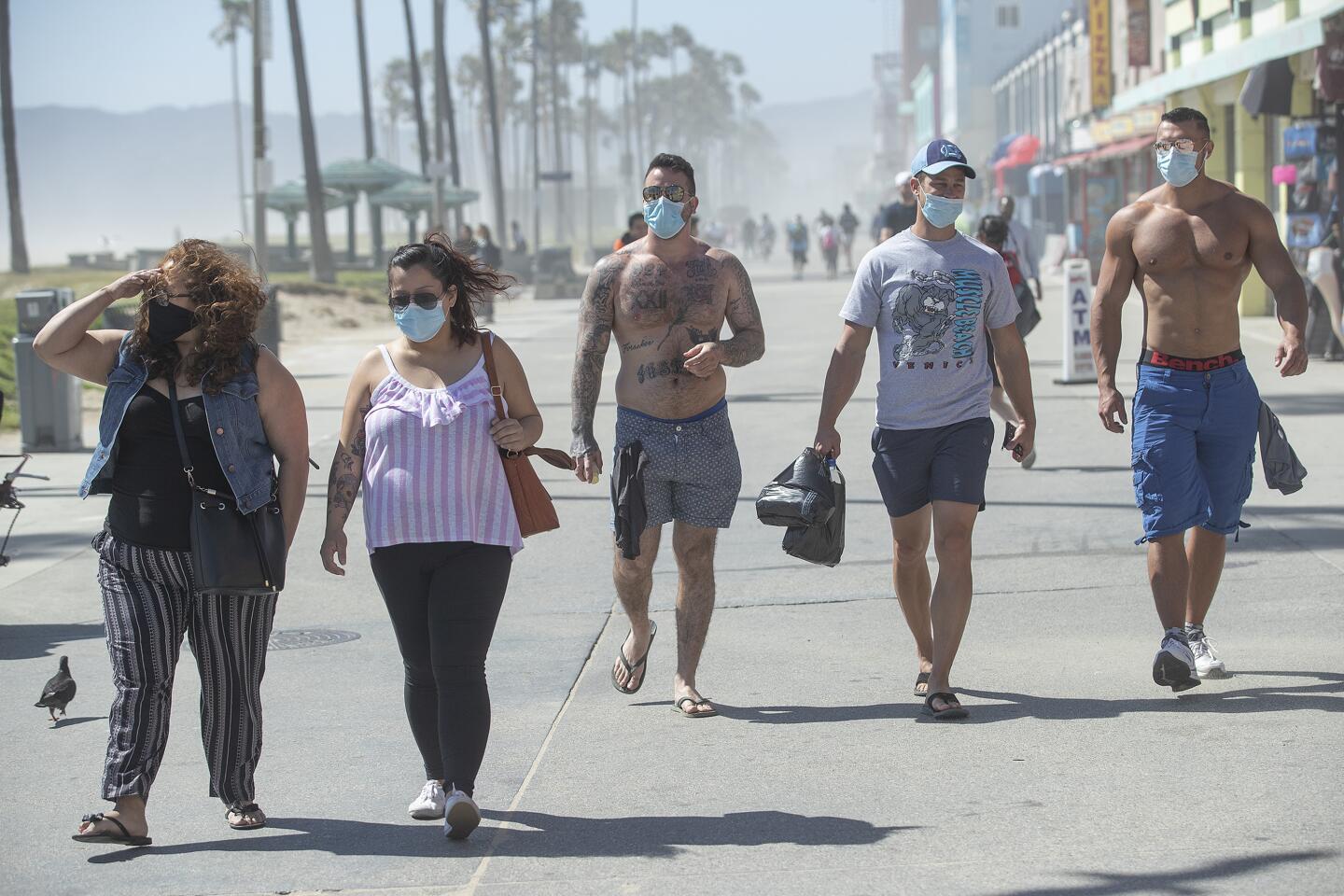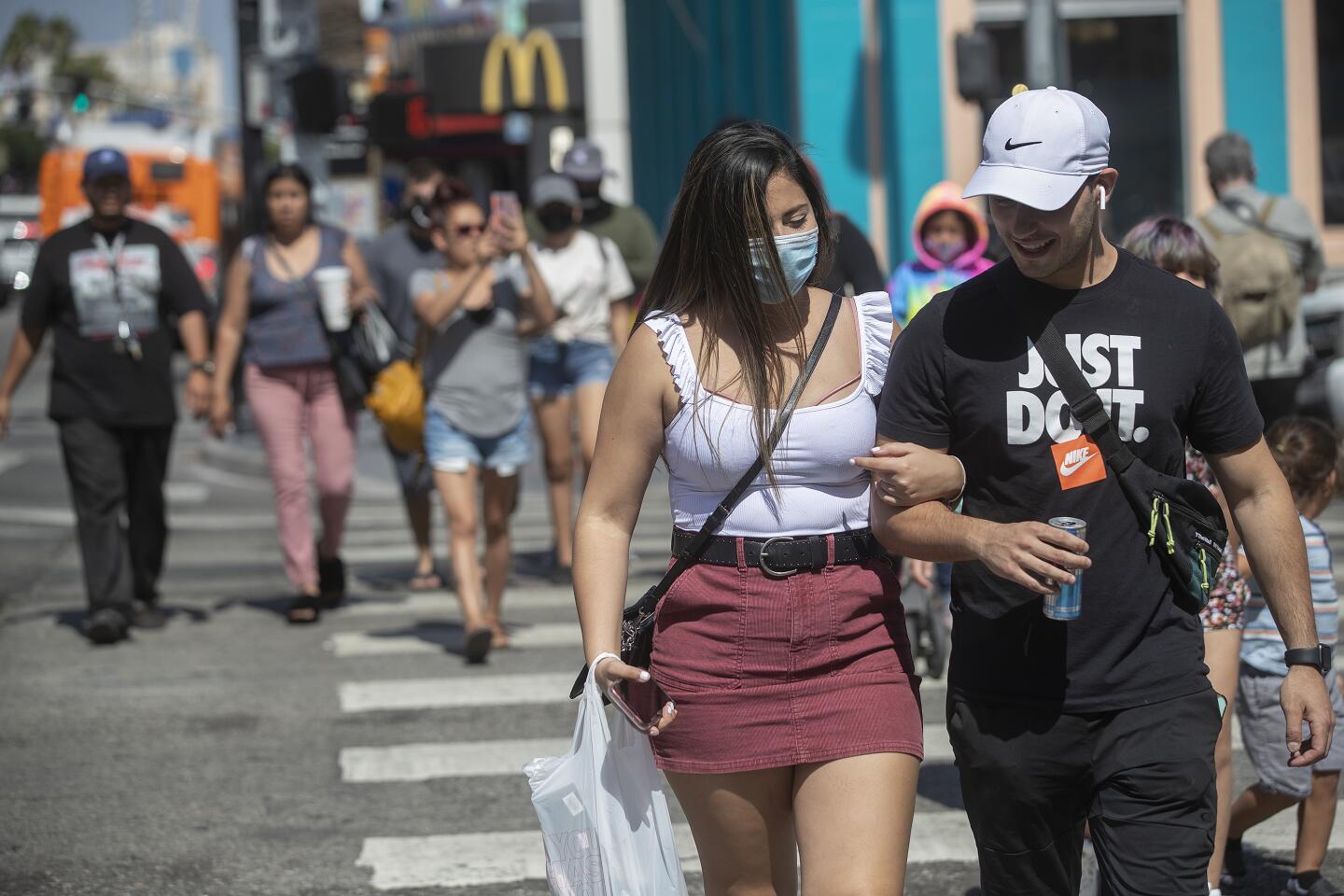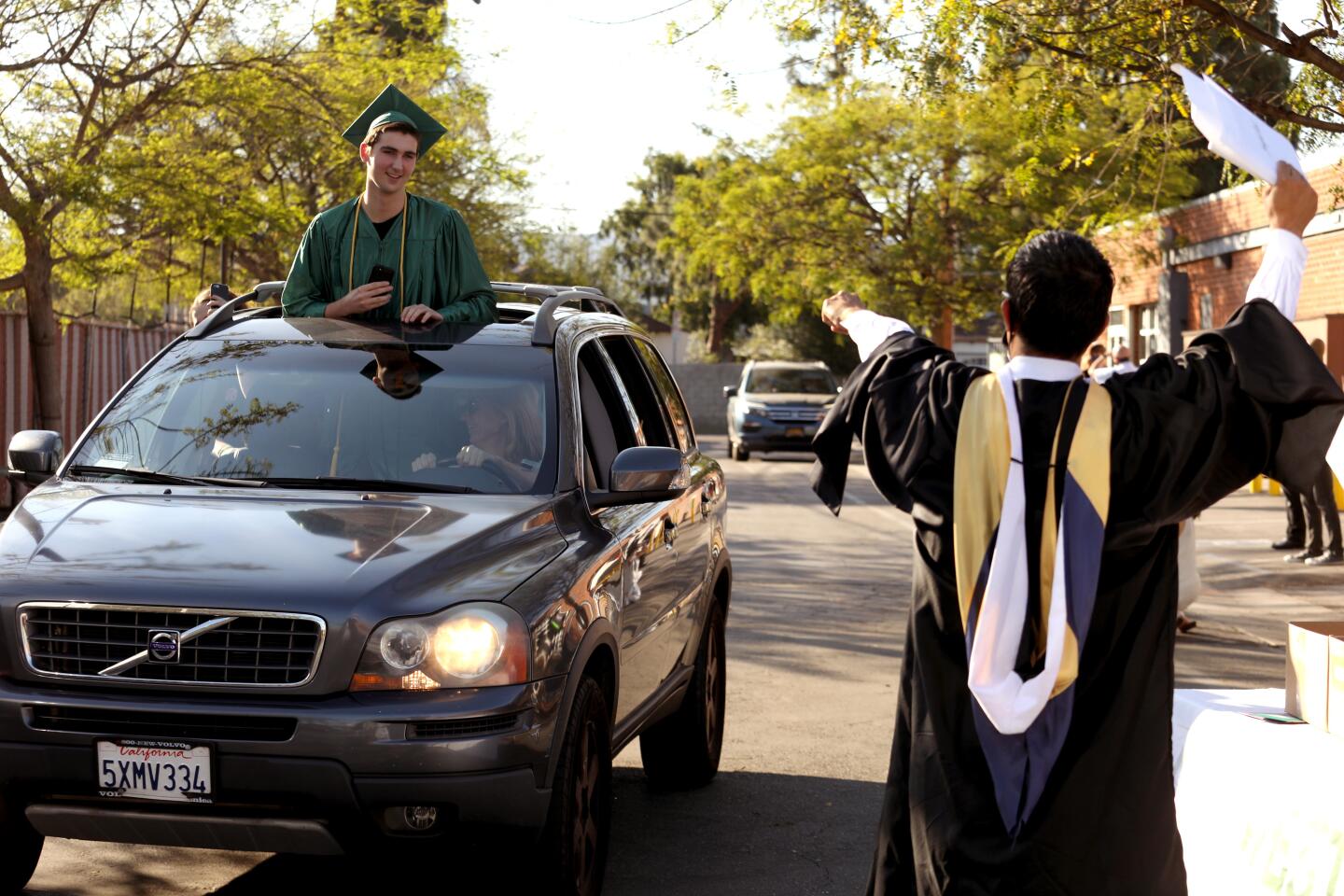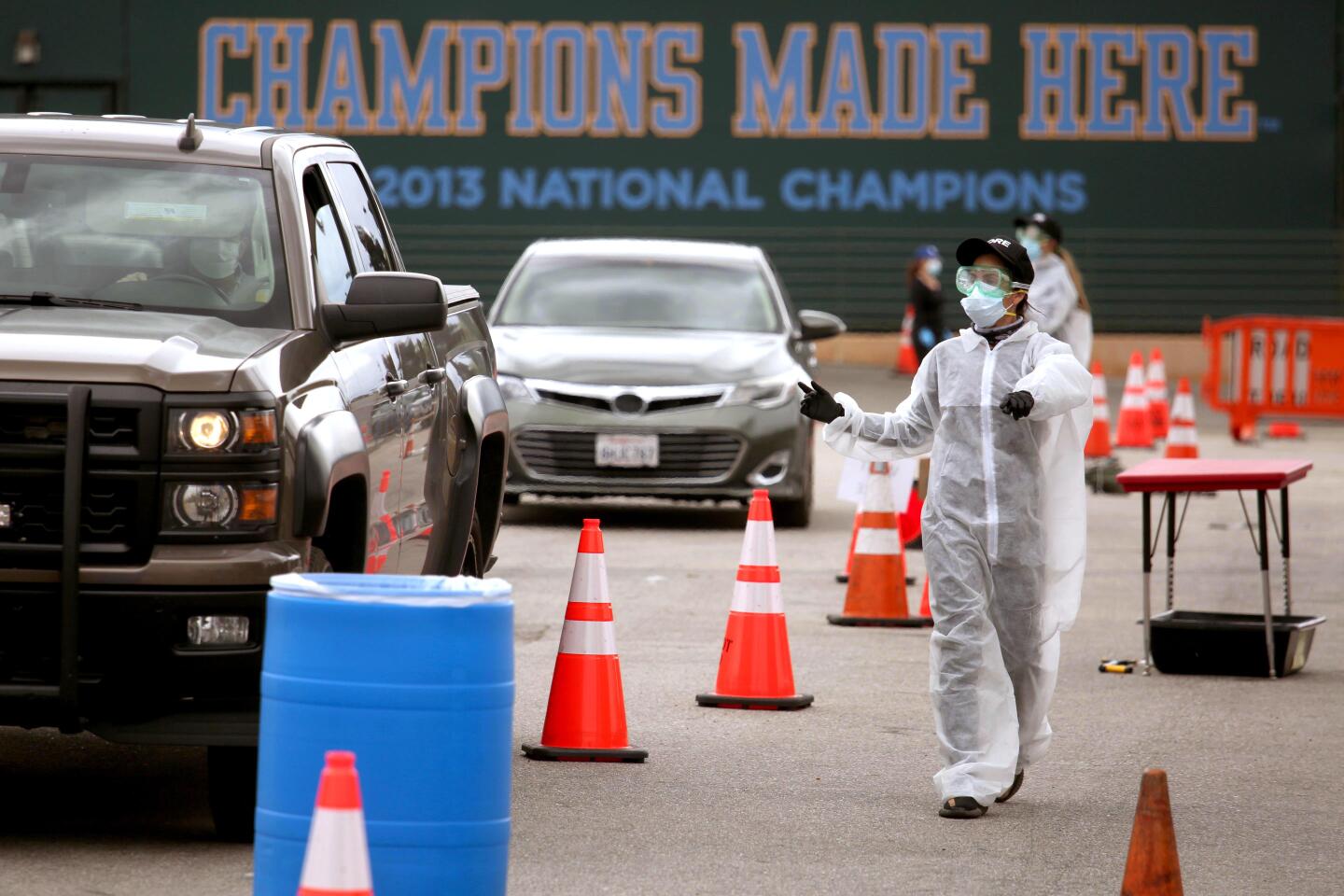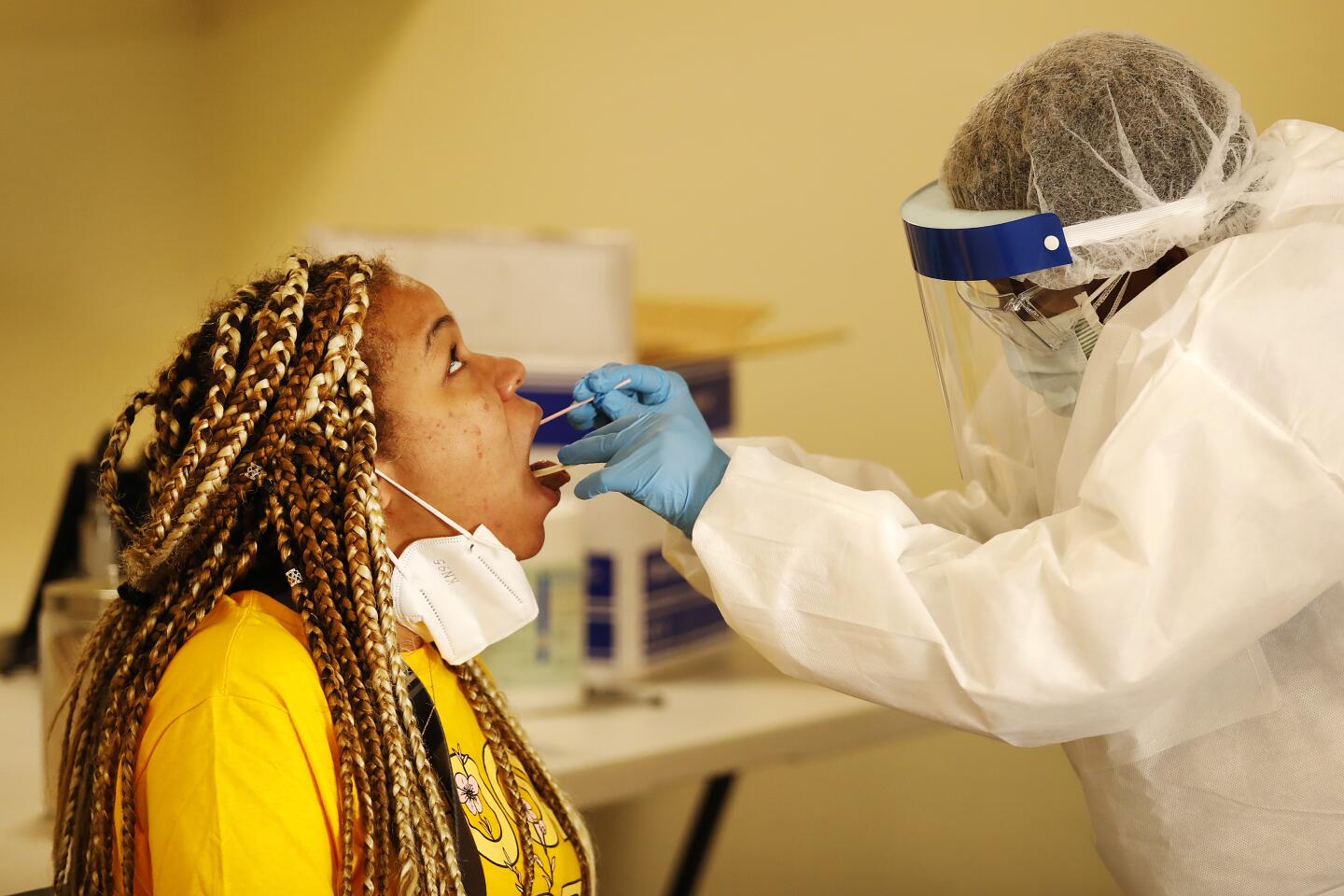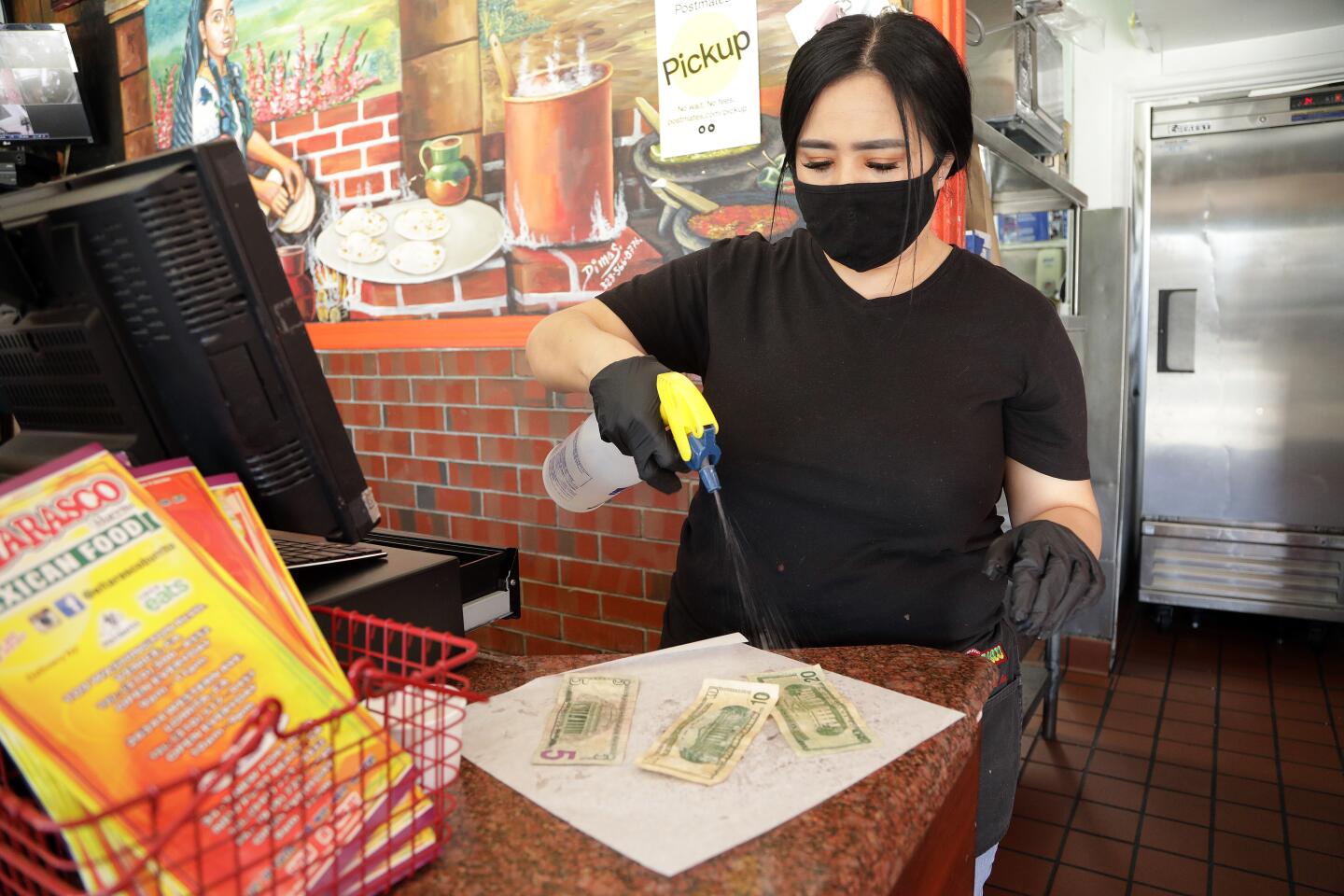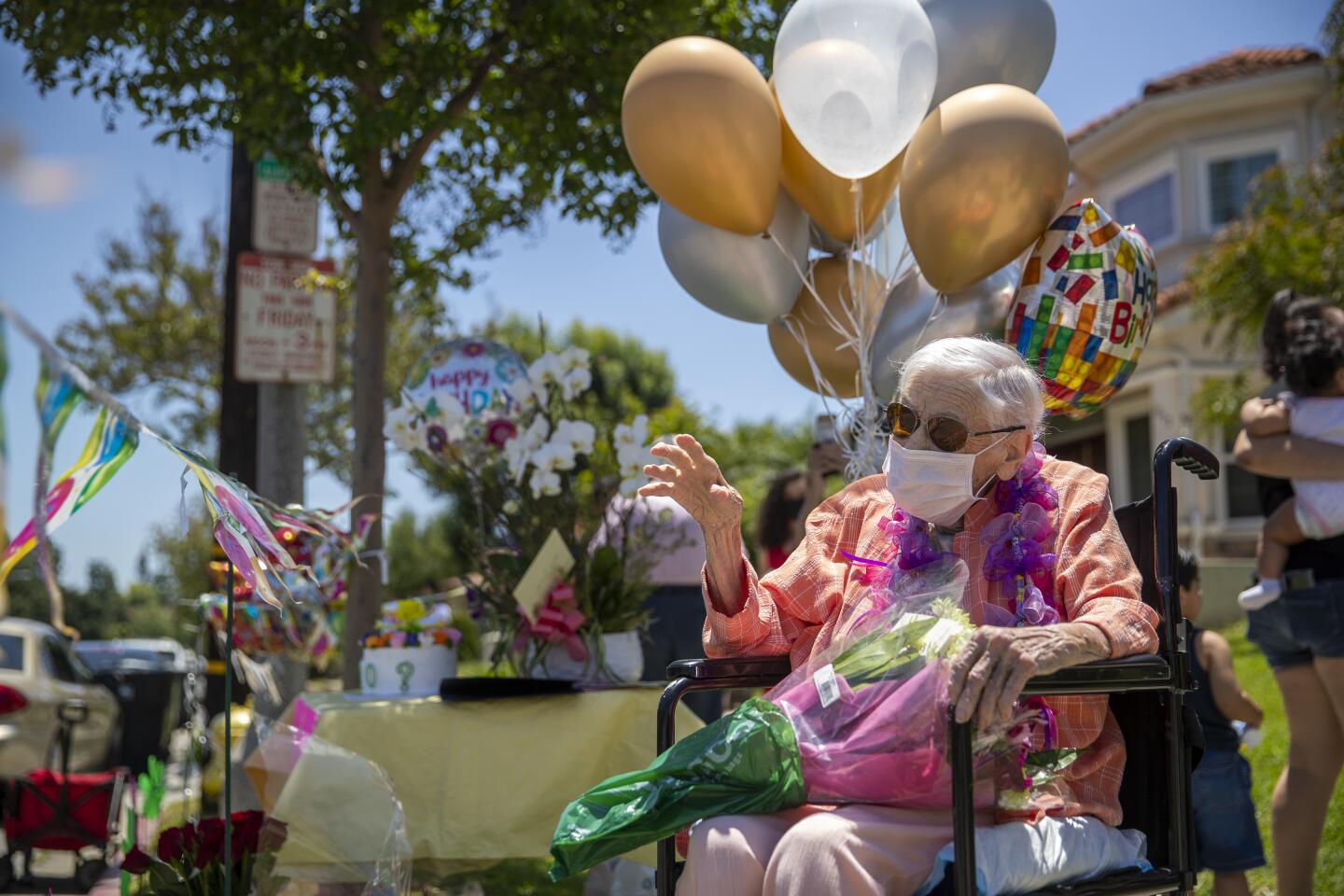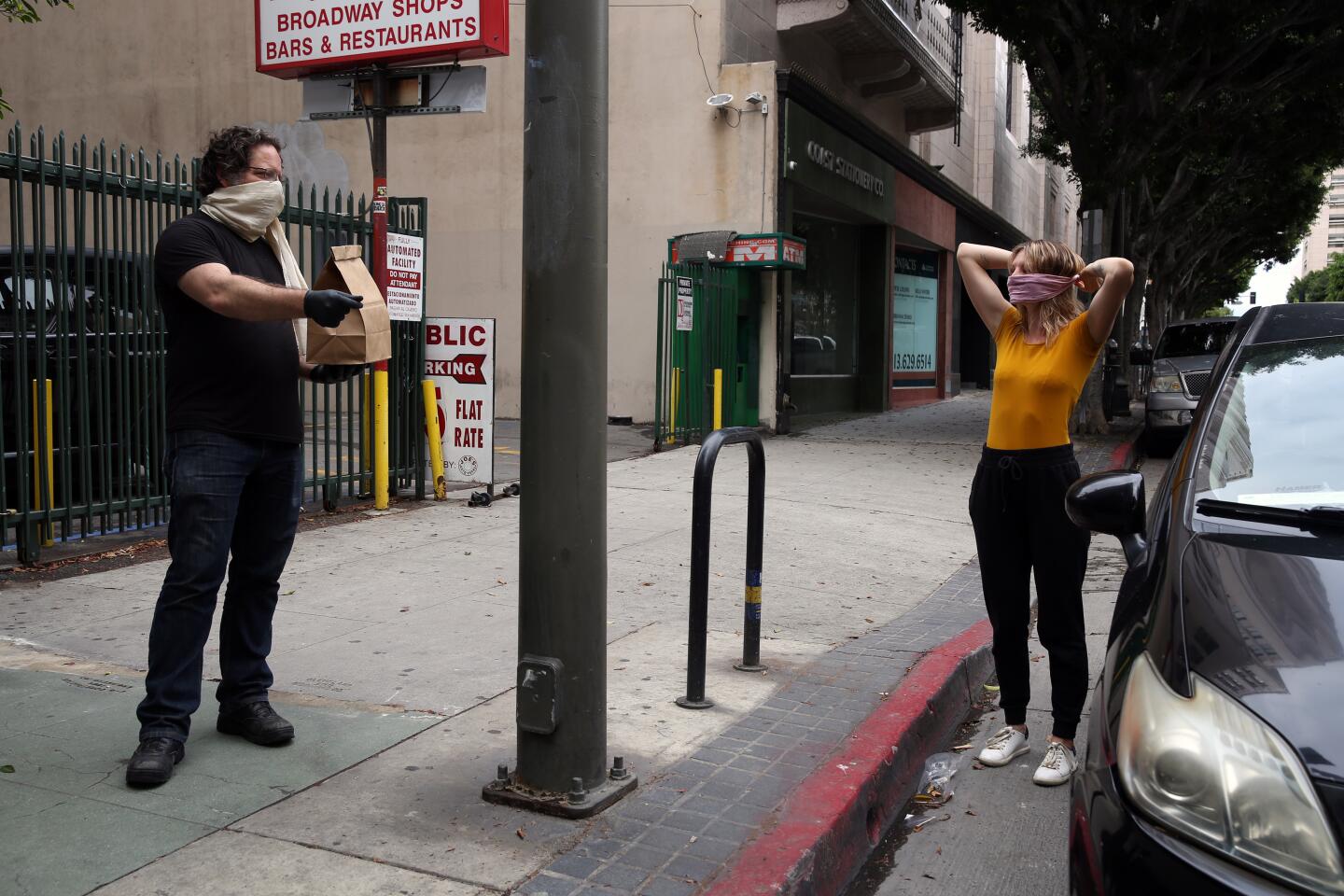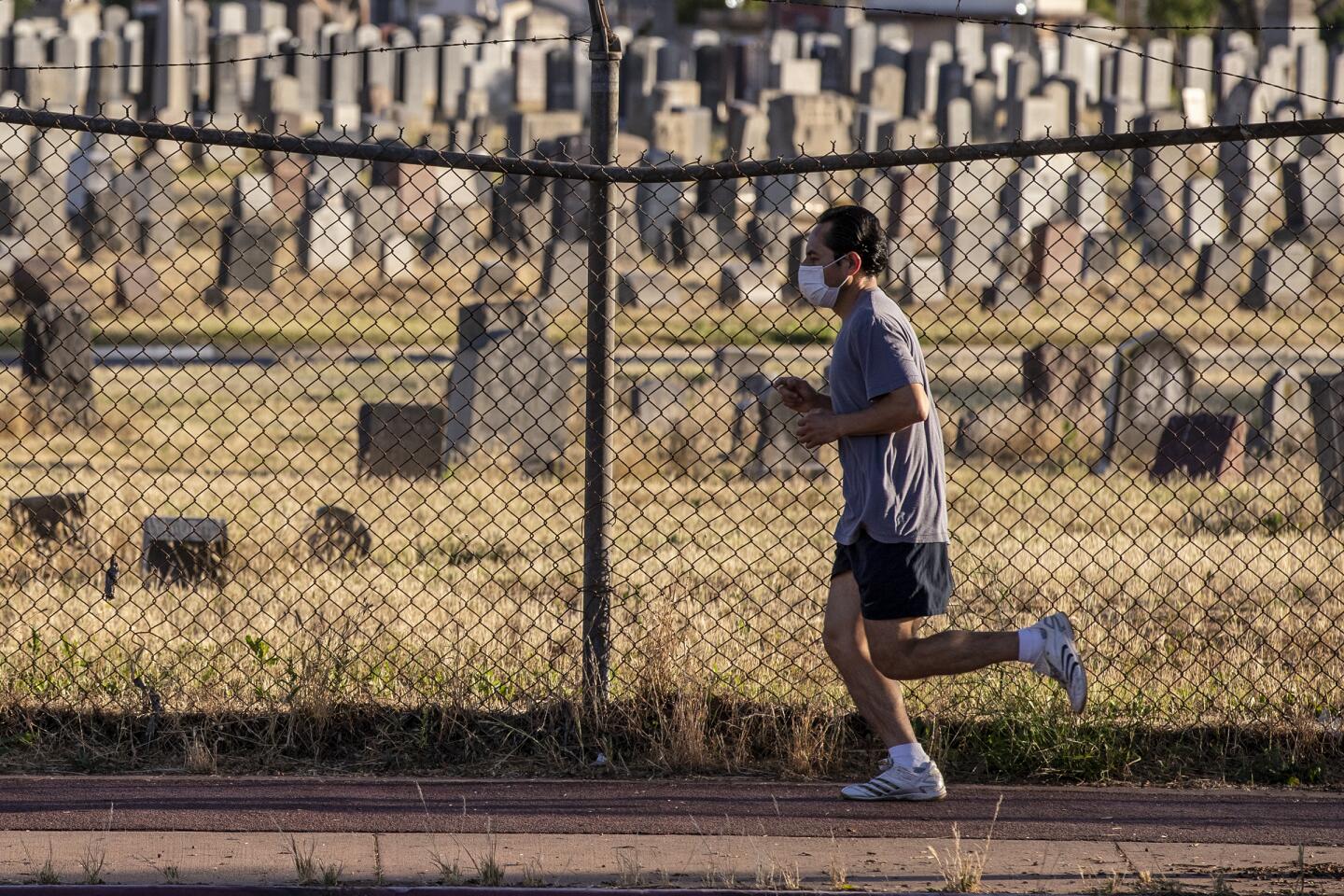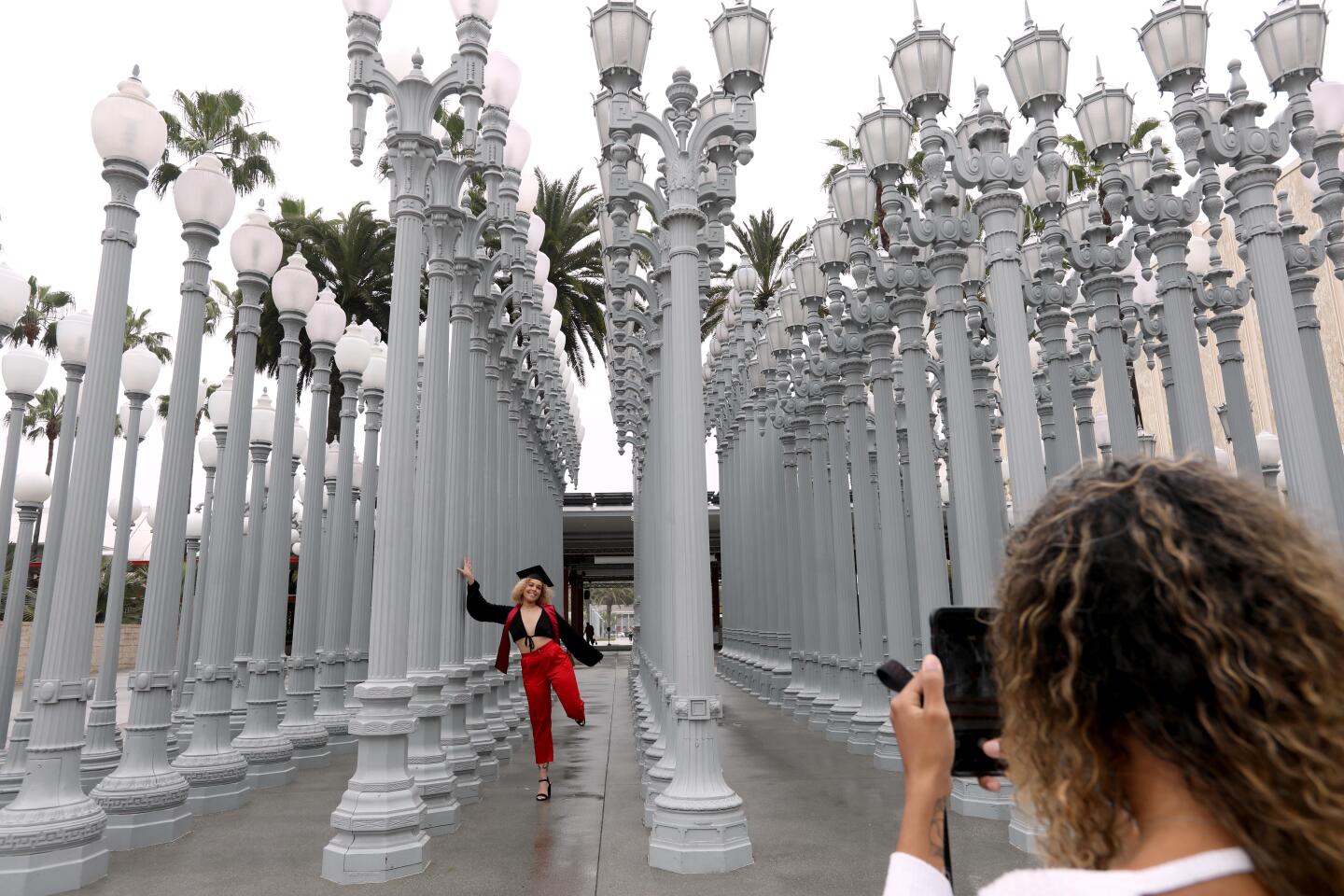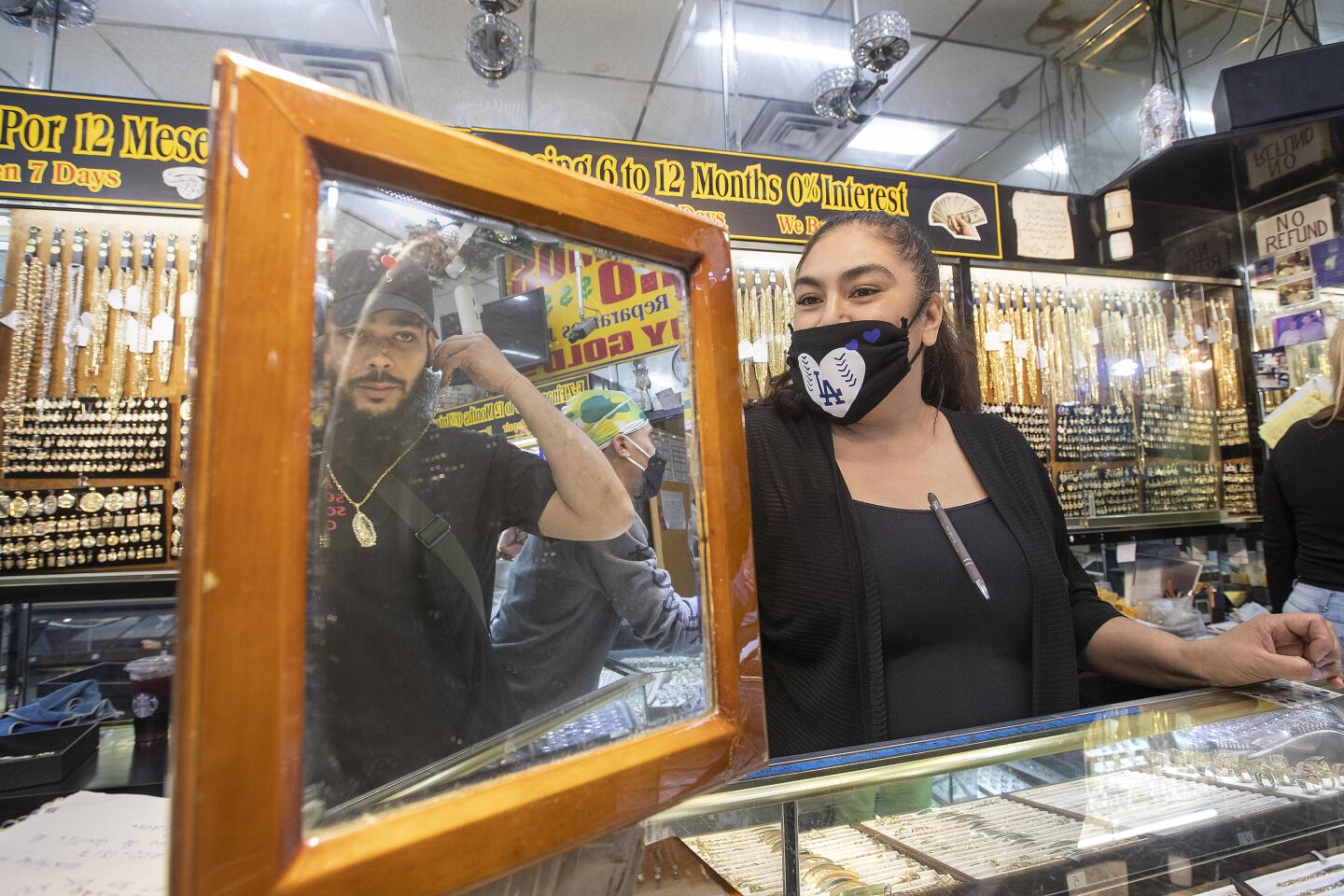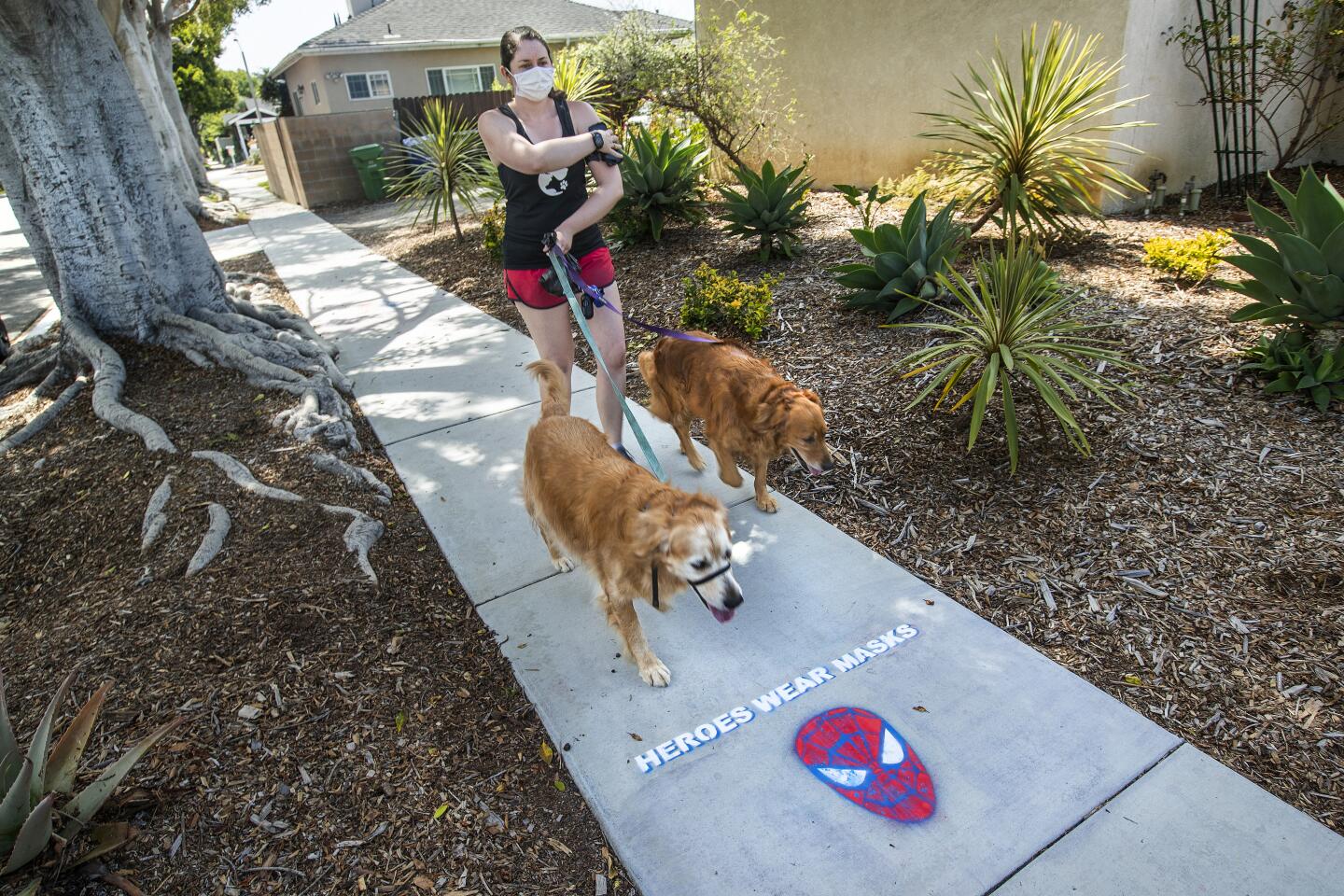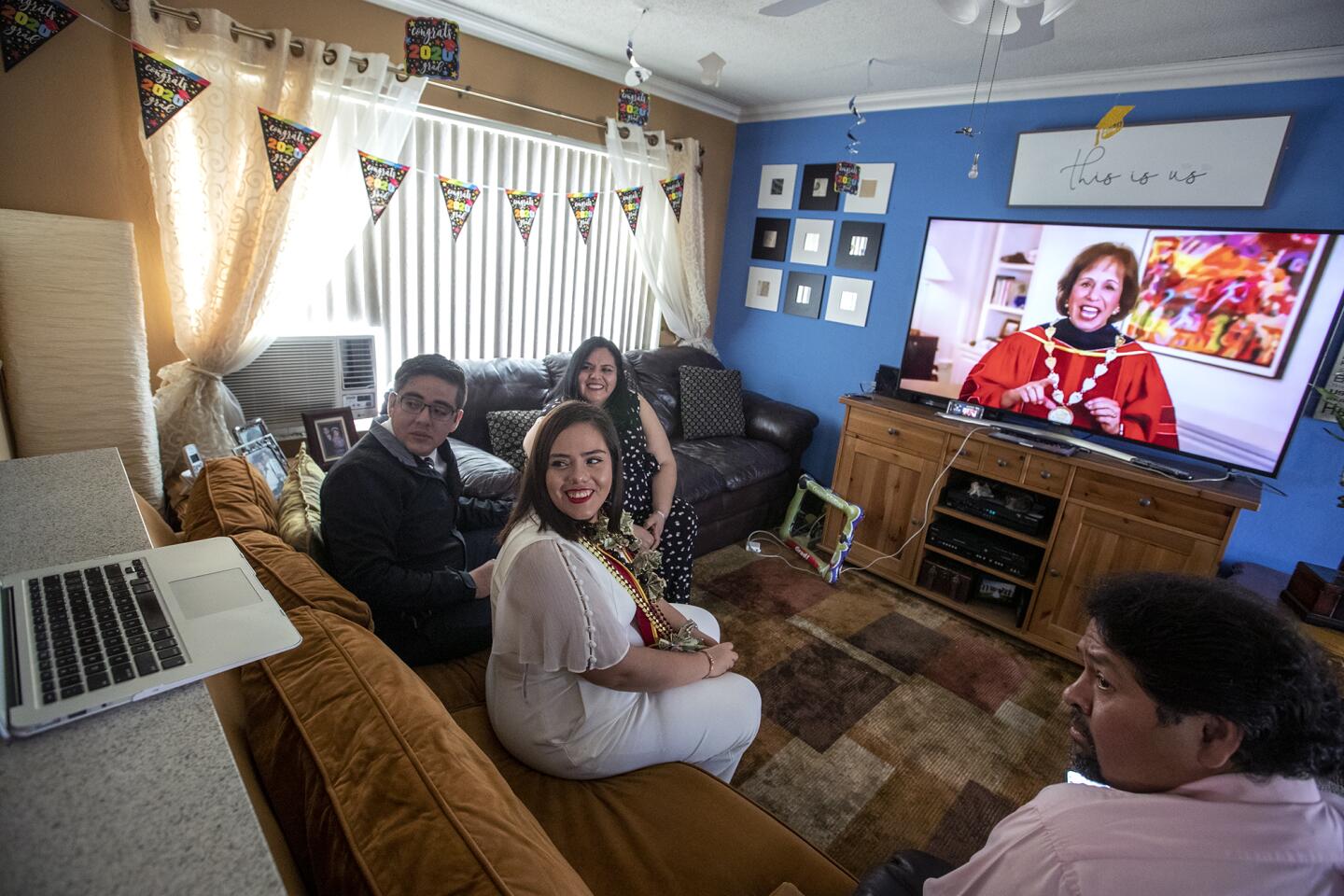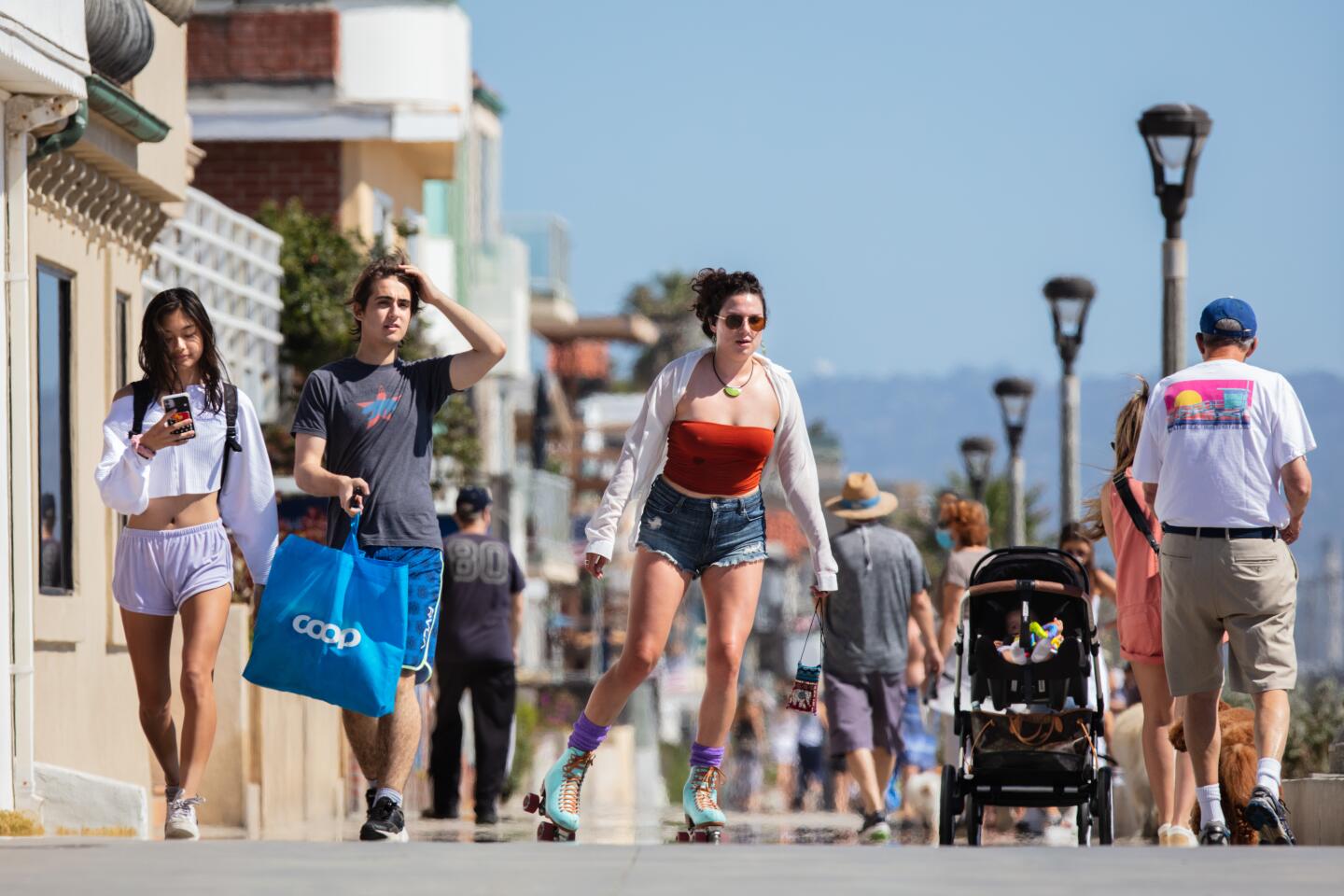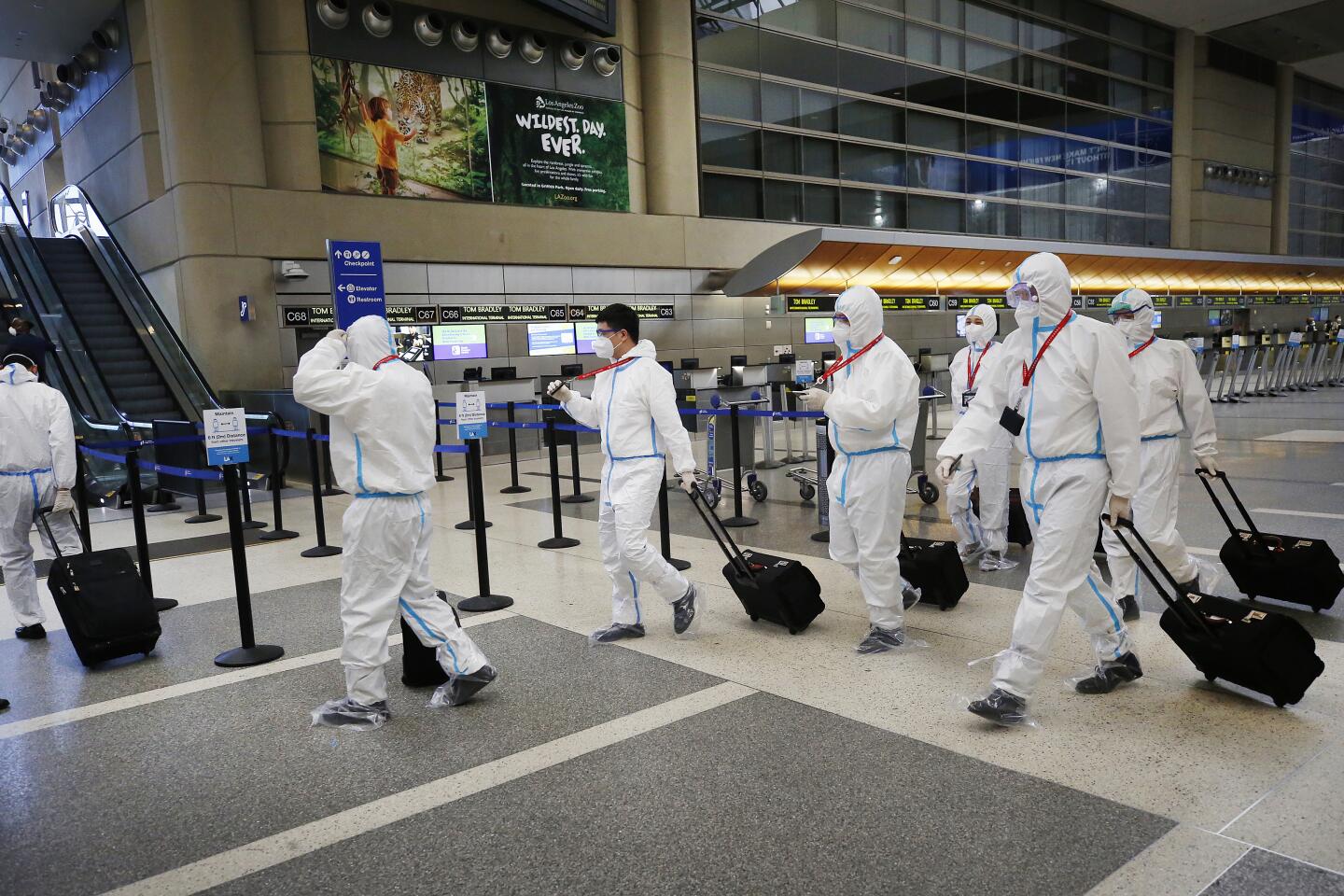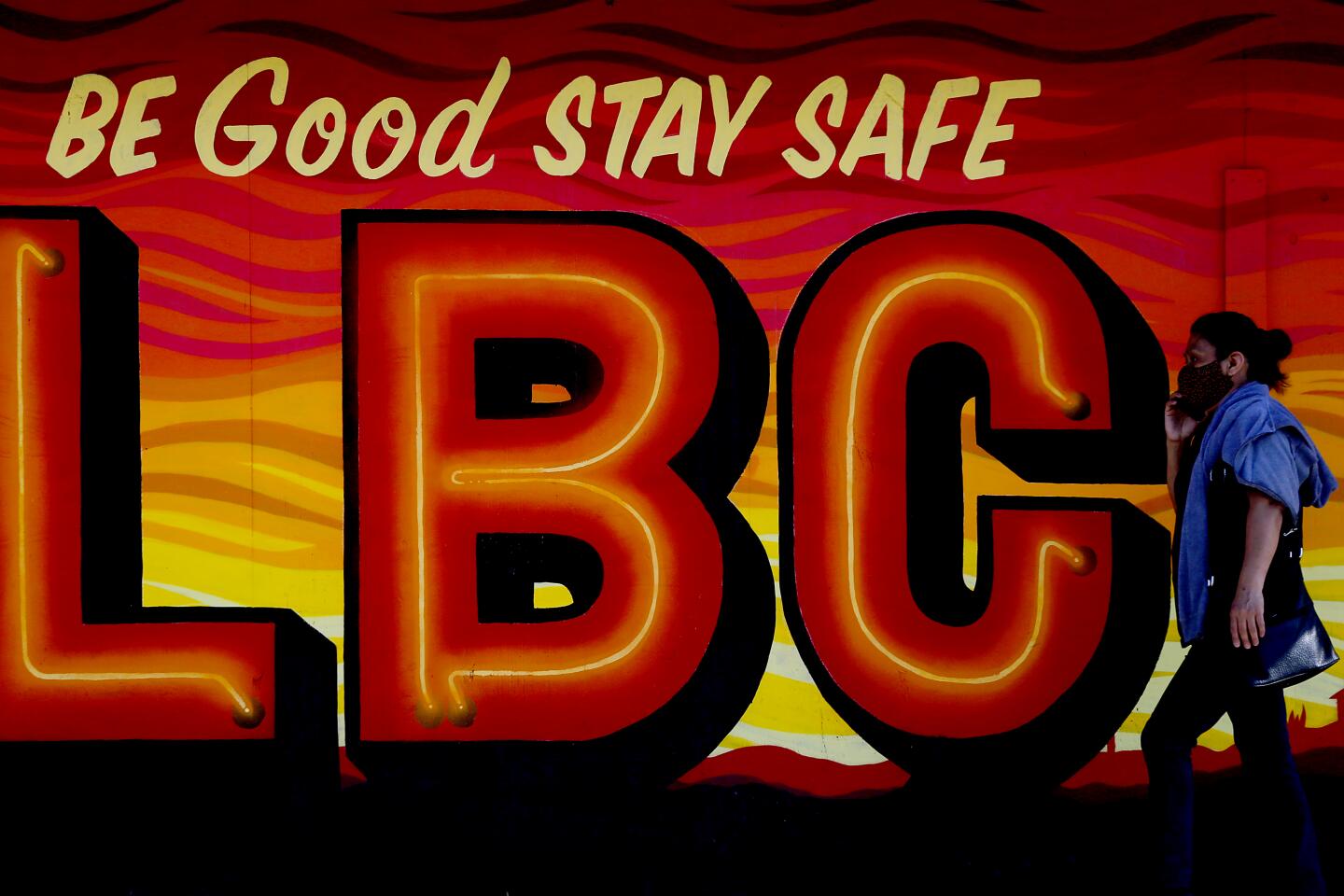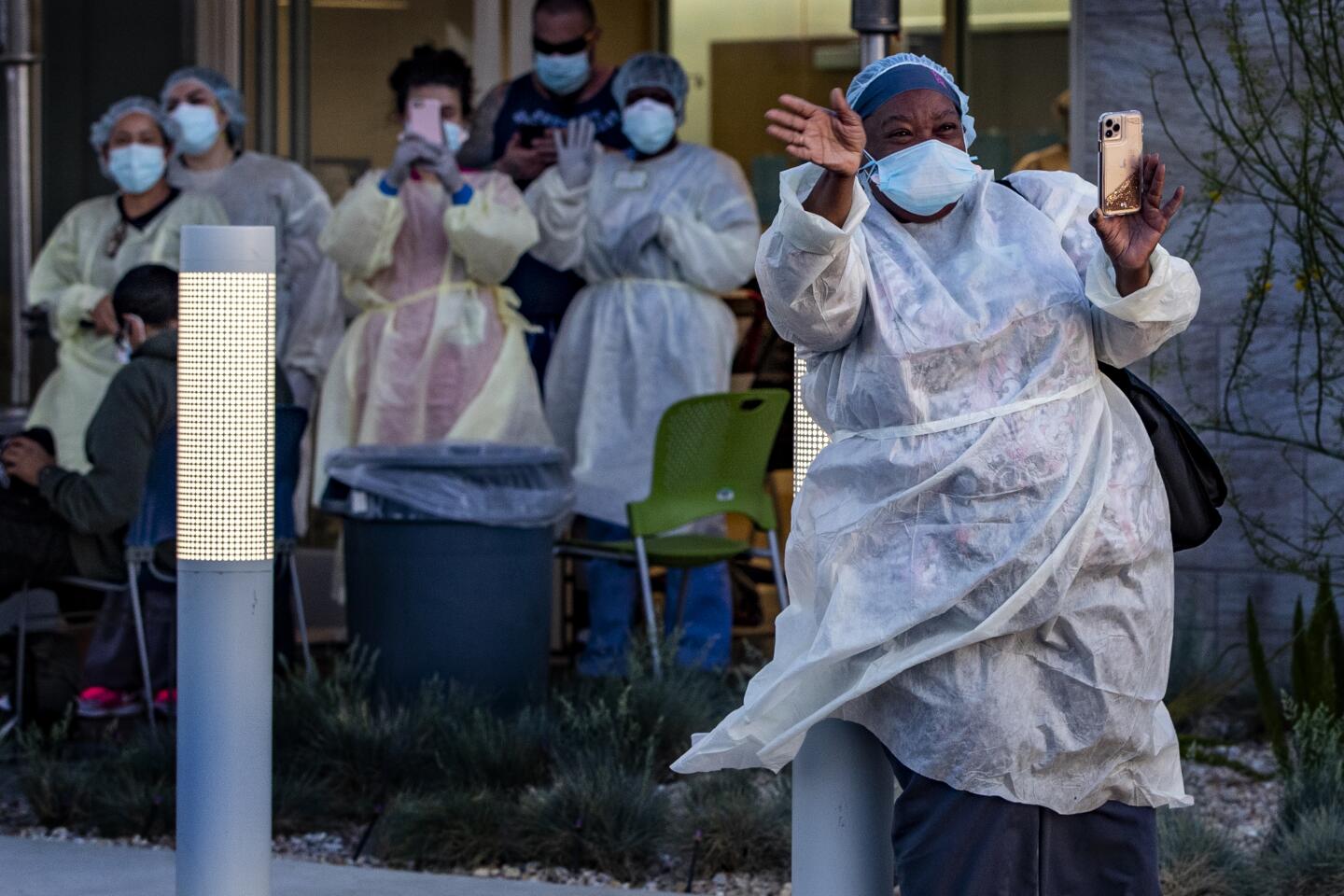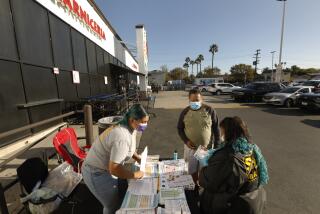Gov. Gavin Newsom said Monday that the surge in coronavirus cases hitting California was due in part to younger people who might believe “they are invincible” but nonetheless are becoming sick from COVID-19.
These are younger adults — who Newsom called “the young invincibles” — who are testing positive for the disease, a trend that has become apparent as the economy has reopened and working-aged adults return to work and had resumed social gatherings.
“So a lot of these younger folks may be coming into hospitals, but with not as acute needs as what we were seeing in the past,” Newsom said. In L.A. County, working-age adults are making up an increasing share of the percentage of those who are hospitalized, while seniors are making up a declining share.
Some young people think “they are invincible but don’t feel it’s going to impact them and if it does, it’s not a big burden.”
But Newsom and other experts have warned that increasing infection in younger adults may serve as a way the disease can spread to those with underlying health conditions and older adults.
That’s why, Newsom said, he has made moves to strengthen public health orders, such as ordering many of California’s most populous counties to shut down bars and indoor restaurant dining rooms as hospitalizations have increased.
1/46
Newport Beach police enforce closures along the Wedge in Newport Beach, a popular surf spot. (Irfan Khan/Los Angeles Times)
2/46
Spectators along the Wedge in Newport Beach, a surf spot, on July 4. (Irfan Khan/Los Angeles Times)
3/46
A bicyclist rides along Highland Avenue with the pier closed to beachgoers on July 3 in Manhattan Beach. (Gary Coronado/Los Angeles Times)
4/46
Peter Gratzinger of Pacific Palisades heads to the water at Santa Monica State Beach, which opened to the public at 5 a.m. July 6. (Myung J. Chun/Los Angeles Times)
5/46
A bicyclist with her child rides along the closed bike path on July 3 in Manhattan Beach. (Gary Coronado/Los Angeles Times)
6/46
A police officer and a lifeguard boat comb the shoreline in Venice Beach on July 5. Even though the beach was closed over the weekend a few still made their way to the shoreline. (Genaro Molina/Los Angeles Times)
7/46
No-parking signs from the July 4 weekend still block spots on Ocean Avenue in Santa Monica on Monday. (Myung J. Chun/Los Angeles Times)
8/46
Dusk sets in over the the Santa Monica Pier on Friday. (Gina Ferazzi/Los Angeles Times)
9/46
Southern California residents watch the fireworks during the Drive-Up 4th of July Spectacular at the Los Alamitos Joint Forces Training Base on Saturday in Los Alamitos. (Gina Ferazzi/Los Angeles Times)
10/46
Bella Nousiainen, left, with daughter, Helmi Nousiainen, of Los Angeles, at the Santa Monica Pier, which reopens after being closed to guests for months because of the coronavirus. (Gary Coronado/Los Angeles Times)
11/46
Dr. Jamie Taylor checks the ventilators at the refashioned St. Vincent Hospital. (Wally Skalij/Los Angeles Times)
12/46
Shoppers and mannequins wear protective masks in the Los Angeles downtown garment district on Thursday. (Luis Sinco/Los Angeles Times)
13/46
Patrons wear face coverings at Grand Central Market in downtown Los Angeles on Thursday. A recent surge in COVID-19 cases in California has pushed the state’s total past 200,000 with more than 5,800 deaths. (Kent Nishimura/Los Angeles Times)
14/46
LAPD officers E. Rosales, left, and D. Castro, patrol the Metro Red Line at the Hollywood/Highland Metro Station Thursday. (Allen J. Schaben/Los Angeles Times)
15/46
Visitors wear protective masks while walking through historic Olvera Street in downtown Los Angeles on Thursday. (Luis Sinco/Los Angeles Times)
16/46
People wait in line to have a COVID-19 screening administered by the Community Organized Relief Effort at the Los Angeles City Mayor’s test site at Dodger Stadium on Thursday. (Gary Coronado/Los Angeles Times)
17/46
A woman adjusts a protective mask while walkiing along Atlantic Avenue in Long Beach. (Luis Sinco/Los Angeles Ti mes)
18/46
Cameron Johnson,18, left, headed to UC Berkeley in the fall and Simona Krasnegor,17, headed to UCLA in the fall, watched the sun set while sitting next to the Manhattan Beach Pier, following their drive-through graduation from Mira Costa High School in Manhattan Beach. (Jay L. Clendenin/Los Angeles Times)
19/46
Jair Guido, 36, a veterinarian visiting from Durango, Mexico, right, wearing a sombrero with an American flag draped over his shoulders, walks with other pedestrians along Hollywood Boulevard in Hollywood. Guido said that he wore this outfit to show people that he is proud to be a Mexican and that he loves America. Gov. Gavin Newsom on Thursday ordered all Californians to wear face coverings while in public. (Mel Melcon / Los Angeles Times)
20/46
A mask-wearing skateboarder and her dog make their way along the boardwalk in Venice Beach. Californians must wear face masks in public under a coronavirus order issued by Gov. Gavin Newsom. (Mel Melcon / Los Angeles Times)
21/46
Pedestrians, some with face coverings, some without, walk past musicians Brent Kendell, background left, and Sam Jones, background right, as they perform at the intersection of Hollywood Boulevard and Highland Avenue in Hollywood. (Mel Melcon / Los Angeles Times)
22/46
People wear masks while walking along the boardwalk in Venice Beach. Californians must wear face masks in public under a coronavirus order issued by Gov. Gavin Newsom. (Mel Melcon / Los Angeles Times)
23/46
Pedestrians cross the intersection of Hollywood Boulevard and Highland Avenue in Hollywood. Gov. Gavin Newsom on Thursday ordered all Californians to wear face coverings while in public, following growing concerns that an increase in coronavirus cases has been caused by residents failing to voluntarily take that precaution. (Mel Melcon / Los Angeles Times)
24/46
Sophia Strauss, left, and Sarah Hoffmeister celebrate after their drive-through graduation from Mira Costa High School in Manhattan Beach. (Jay L. Clendenin / Los Angeles Times)
25/46
New West Charter School vice principal Mark Herrera shouts at graduate Joe Reid to come and receive his diploma during a drive-up graduation ceremony for the Class of 2020 at the charter school in Los Angeles. (Genaro Molina/Los Angeles Times)
26/46
A worker directs drivers at a drive-up testing site for COVID-19 outside of Jackie Robinson Stadium at UCLA.
(Genaro Molina/Los Angeles Times)
27/46
Destiny VanSciner is tested for COVID-19 with an oral swab by family nurse practitioner Anniesatu Newland at a walk-in site at St. John’s Well Child and Family Center in South Los Angeles. (Al Seib / Los Angeles Times)
28/46
Melissa Gomes fixes the tassel on the mortarboard of Sarah Anggraini as the new graduate gets ready for a photo at Chaffey College, which held a drive-through graduation, in Rancho Cucamonga. (Irfan Khan / Los Angeles Times)
29/46
Maricela Moreno, manager at El Tarasco in Marina del Rey, disinfects cash at the restaurant. (Myung J. Chun / Los Angeles Times)
30/46
Mildred “Millie” Stratton waves to a caravan of cars led by Alhambra police officers and firefighters. The parade past her home celebrated Stratton’s 102nd birthday. (Allen J. Schaben / Los Angeles Times)
31/46
Eric Larkin hands an order to Brittany Wright as she fastens her face covering outside the Last Bookstore in downtown Los Angeles. (Dania Maxwell / Los Angeles Times)
32/46
A jogger passes Evergreen Cemetery in Los Angeles as local stay-at-home orders are increasingly relaxed months into the coronavirus outbreak. (Robert Gauthier / Los Angeles Times)
33/46
Hikers and bikers traverse the Santa Fe Dam trail as county parks officially reopen to the public. (Robert Gauthier / Los Angeles Times)
34/46
A woman, masked against COVID-19, walks past a building that features the image of Britney Spears at a shopping center in the Fairfax District of Los Angeles. (Genaro Molina / Los Angeles Times)
35/46
Manon Guijarro, a new graduate of Pierce College, has her photo taken by friend Paige Johnson at Chris Burden’s outdoor work “Urban Light” at the Los Angeles County Museum of Art in Los Angeles. (Genaro Molina / Los Angeles Times)
36/46
Mary Perez, a salesperson at High Class Jewels on Broadway in downtown Los Angeles, helps a customer as he tries on a gold rope chain inside the recently reopened store. (Mel Melcon/Los Angeles Times)
37/46
Professional dog walker Lindsay Rojas takes golden retrievers Gomez, left, and Nikki for a stroll along Le Bourget Avenue in Culver City. (Mel Melcon / Los Angeles Times)
38/46
The Air Force Thunderbirds precision flying team banks over downtown Los Angeles in formation to salute healthcare workers and first responders on May 15. (Brian van der Brug / Los Angeles Times)
39/46
Maria Morales, center, a member of the USC class of 2020, participates in virtual graduation via Zoom with her brother Manny Morales, left, mom Pilar Morales and stepdad Victor Ramos from her home in Orange. (Brian van der Brug / Los Angeles Times)
40/46
On a recent day, there’s not a face mask in sight as a roller skater and others share the reopened walking path on the Strand in Manhattan Beach. (Jay L. Clendenin / Los Angeles Times)
41/46
Crew members of a Hainan Airlines flight walk through the Tom Bradley International Terminal at Los Angeles International Airport. (Al Seib/Los Angeles Times)
42/46
A woman wearing a protective mask walks past a shuttered business in Long Beach. (Luis Sinco/Los Angeles Times)
43/46
Thousands of rental cars are stored at Dodger Stadium as the coronavirus crisis has caused rentals to nosedive. (Robert Gauthier/Los Angeles Times)
44/46
Some beachgoers actively use the beach while others relax on the sand, despite Gov. Gavin Newsom’s active-use-only order, in Huntington Beach. (Allen J. Schaben/Los Angeles Times)
45/46
Traveling nurse Gail Cunningham waves thanks outside the emergency room entrance to Riverside University Health System in Moreno Valley as residents pay tribute to her and other medical personnel with a drive-by rally. (Gina Ferazzi/Los Angeles Times)
46/46
A scene from “Knives Out,” with actor Don Johnson, seen at the Mission Tiki Drive-in Theatre in Montclair. Opened with one screen in 1956, the Mission Tiki expanded to four screens in 1975 and began renovation in 2006, updating to FM transmitters and digital projectors. (Jay L. Clendenin/Los Angeles Times)
While a higher percentage of coronavirus tests is confirming infections, “we’re not seeing a commensurate increase yet in mortality,” Newsom said. For the last six weeks, California has reported an average coronavirus death toll of about 436 a week since Memorial Day; for the preceding six weeks, the average weekly death toll was 510, a Times analysis found.
“Those are lagging indicators: hospitalizations, ICUs and deaths,” Newsom said.
It can take weeks for newly infected people to get sick enough to be hospitalized, and even more time before they die from the disease.
Experts say it can take three to four weeks after exposure to the virus for infected people to become sick enough to be hospitalized, and four to five weeks after exposure for some of the most vulnerable patients to die from the disease.
The same trends of younger adults being increasingly infected with the coronavirus is being seen in L.A. County.
By the Fourth of July, “almost 50% of new cases occur among younger people,” which are adults 40 and younger, said Barbara Ferrer, the L.A. County director of public health, on Monday. In early April, that age group made up only about 30% of new confirmed cases.
Adults 18 to 39 make up about one-third of L.A. County’s population.
The decline in deaths in L.A. County is partly due to a significant decline in new deaths among nursing home residents. In May, L.A. County was reporting an average of 25 daily coronavirus deaths among nursing home residents. By late June, the average daily death toll from nursing homes was about 10, Ferrer said last week.
Officials have said better use of personal protective equipment, such as masks, gowns and gloves, and increased testing, has helped reduce the effect of the pandemic on nursing homes.
The age makeup of those being hospitalized in L.A. County has also changed. In late April, seniors 65 and older made up 50% of those hospitalized with COVID-19; middle-aged people between 41 to 64 made up more than 35%; and the youngest adults made up less than 15% of cases.
Now, it’s working-aged adults who are seeing their share of hospitalizations rise, while the elderly’s rate falls. By the Fourth of July, middle-aged adults made up roughly 45% of hospitalizations; seniors made up less than 30%; and the youngest adults made up more than 25% of hospitalizations.
There are several reasons why younger adults are increasingly becoming infected, Ferrer said, citing survey results compiled by the USC Dornsife Center of Economic and Social Research.
More L.A. County residents are leaving their home. In mid-April, 86% of L.A. County residents said they stayed home at all times except for essential activities or exercise; by the last week of June, only 58% said they were doing so.
More L.A. County residents are also having close contact with people outside of their household. In mid-April, only 31% of L.A. County residents had such close contact with people outside of their household; by the last week of June, 55% were doing so.
As the reopening has accelerated, however, fewer L.A. County residents are reporting a fear of running out of food because of a lack of money or other resources. In early April, 30% of L.A. County residents surveyed were worried about running out of food; that figure has fallen to 11% for the last week of June.
Additionally, fewer L.A. County residents are now reporting psychological distress as the reopening accelerated. In early April, 47% of surveyed county residents reported mild, moderate or severe symptoms of psychological distress; as the reopening accelerated, 36% reporting feeling such symptoms.
There was also a slight reduction in the percentage of L.A. County residents who reported the pandemic posed a moderate or substantial threat to their household finances; 64% said it did so in mid-May; 56% said it did so in mid-June.
“This is the good news about opening — it’s that in fact, for many people, it’s provided some very important and much needed relief,” Ferrer said.
But as people have returned to physical work locations, workplaces have increasingly become sites of exposure to the highly contagious virus. While in early May, 37% of surveyed L.A. County residents said their job required them to come within six feet of other people regularly, 43% said they had done so in mid-June.
More L.A. County residents are increasingly concerned California is lifting restrictions on public activity due to the pandemic too quickly, the survey found. While 75% of survey respondents expressed such worry in early May, 79% did so in mid-June.
The rate at which coronavirus tests in California are coming back positive has jumped 42% over the last two weeks, according to data published on the Los Angeles Times’ California coronavirus tracker. An increasing rate of positive test results is an indication that disease transmission is worsening.
The Fourth of July marked the 15th consecutive day that California tallied record hospitalization numbers of confirmed coronavirus patients. On Saturday, the state recorded 5,669 patients with confirmed coronavirus infections in California hospitals — an increase of 62% over the previous two weeks.
On June 27, just a week earlier, the state had reported 4,498 hospitalized patients with confirmed cases of COVID-19. On June 20, the number was 3,494.
The number of intensive care unit patients statewide with confirmed coronavirus infections is up 63% over the last three weeks. On Saturday, there were 1,711 people with confirmed coronavirus infections in the ICU; on the previous Saturday, there were 1,376; the week before that, there were 1,149; and on June 13, there were 1,049.
Newsom said Monday that California is now monitoring 23 counties for surges in coronavirus cases and hospitalizations. That’s four more since last week.
Counties on the watch list include: Contra Costa, Colusa, Fresno, Glenn, Imperial, Kern, Kings, Los Angeles, Madera, Marin, Merced, Monterey, Orange, Riverside, Sacramento, San Bernardino, San Diego, San Joaquin, Santa Barbara, Solano, Stanislaus, Tulare and Ventura.

